
Winsley Quiambao of Nuga Sushi
THE WORLD’S NORTHERN MOST SUSHI RESTAURANT


THE WORLD’S NORTHERN MOST SUSHI RESTAURANT
What a busy quarter it has been! Many of us have started bidding farewell to winter to welcome the gentle warmth of spring. Days have started getting longer, and with that a renewed sense of wonder and adventure.
It is with great pleasure that we unveil the latest issue of Roots & Wings magazine. In this issue, you'll discover a tapestry of stories, insights, and inspirations that mirror the kaleidoscope of experiences shared by our ‘kababayans’ around the world. We invite you to journey with us around the globe to discover the world’s northern most sushi restaurant, delve into Filipino artist Rai Cruz’s cabinets and curiosities, explore the world of fashion, resilience and endless possiblities, get to know Global Filipina, Regine Borja Guevarra, or learn more about Filipinos in Tech.
March is also a special month with the 8th of March marking International Women’s Day. “The journey to achieving gender equality is perhaps still long. However, every step that each of us take in showing our capabilities as women makes us powerful agents of change.”
Hear from three ‘Women on the Lead’ as they talk about their professional journey in Germany. From thought-provoking features to captivating visuals, each article is a testament to the beauty of diversity and the power of storytelling. It’s been said before, but I will say it again – it is truly remarkable to see the achievements of Filipinos at home and abroad… I am so glad that we are able to share these stories with you, and hope that they inspire you, uplift you, and remind you of the endless possibilities that await when we embrace life’s many seasons.
Meanwhile, I wish you and your families a joyous Easter.
Happy reading!
Rebecca Urbančík Garcia
















Feedback Page
What do you think of our magazine? Email rawmags.rebecca@gmail.com
Follow us on social media:
Instagram: @Raw.mags
Twitter: @rawmags




Would you like to join our Rawmags Team?
Volunteer roles now open for Bureau Editor Greece, Ireland, Poland and Turkey. Email rawmags.rebecca@gmail.com
Facebook: @rawmags
youtube: @rawmags linkedin/rawmags
www.rawmags.com
Filipinos Run the World’s Northern most Sushi Restaurant p5
Art and Life p10
Operetta “An der Schwemm" p12
Women on the Lead p14
Roots of Resilience p19
Regine: A Global Filipina p23
Thriving Abroad: Let this award-winning book guide you p25
Through the Eyes of Arlo Jake Lagmay p27
Promoting Filipino values: A new beginning for children in Sweden p31
Philippine Embassies in Europe p34
Francis Rafal p36
Young Filipino Tech Professionals in Barcelona
Gather at Consulate for “Woman in Tech”
Empowerment Talk p40
Moving to the Philippines p42
Historical churches in Manila p45

Words and images by
Jennifer FergesenSome days there is no tuna at Nuga, the world’s northernmost sushi restaurant. Restaurants in Svalbard, a Norwegian archipelago just 800 miles from the North Pole, depend on air deliveries for fresh fish and other perishables; the weather is occasionally so rough that no planes can land. Nuga chef and co-owner Winsley Quiambao has a few backup plans, including reaching out to other local chefs for trades or raiding the deep-freeze for local Svalbard cod he caught in the summer. But on days without even a salmon filet, he’s up
front with his customers.
“If we’re not getting this fish this day, we have to send an email or at least message all of those bookings if they want to still have the booking or not, because 50% or 60% of the people who are eat ing here are looking for fish, mainly,” said chef and co-owner Winsley Quiambao. “That’s the biggest challenge.”
Quiambao, 31, has learned to adapt to many challenges since he arrived in Svalbard a decade ago. Born in Japan, he grew

up in Angeles City, Pampanga and moved to Longyearbyen, the largest settlement on the Arctic archipelago, less than a year after he finished his bachelor’s degree in hotel and restaurant management. He arrived in December, the peak of the dark season, when the sky is midnight-black 24 hours a day — with the exception of the moon, stars and the occasional green flame of aurora borealis.
“It was really cold, and a totally different culture and weather, and it’s totally dark,” Quiambao said. “So I didn’t know if I could adapt and find a job here.”
He is one of hundreds of Filipinos who have asked
themselves the same questions about Svalbard over the past few decades. Though the archipelago is under Norwegian sovereignty, it is subject to a century-old treaty that effectively allows people of any citizenship to live and work there legally. This visa-free status attracts many hopeful immigrants, especially those from countries with relatively weak passports and currencies like the Philippines.
Filipinos are 5% of the population of Svalbard
In practice, settling in Svalbard is more difficult than it may seem. Most residential buildings are owned by large companies or the state and local government, and there are few options for those whose housing is not provided by their employers. Nevertheless, Filipinos have found their niche. As of June 2023, 115 Filipino citizens were living in Longyearbyen, making them about 5% of the population and second only to Norwegians in number. There are Filipinos working in almost every hotel, restaurant and store in town, and the school and kindergartens are full of children fluent in Tagalog or another dialect as well as Norwegian and English.
There are signs that Svalbard’s laissez-faire approach to immigration is being dialed back. Until 2022, anyone who had lived in Svalbard for at least three years could vote in local elections; an electoral law change restricted that right to those who had lived in mainland Norway for at least three years. Quiambo was one of hundreds of people who lost their voting rights in 2022, but he said he has more important

things to worry about.
“We are still making money, we are still able to live here freely without limits. So removing your voting rights is not going to affect you. Some people cannot accept the fact that they cannot vote any more, so they are retaliating against the changes,” Quiambao said, referring to the protests that have taken place a few times a year since the change. “Not me, because I have a lot to do.”
It’s been a busy decade for the chef. He put in time at most of Longyearbyen’s restaurants in his first years in town, ending up on the breakfast shift at Svalbard Hotell. One of his coworkers at the hotel, Sten-Erik Allikas, is the kind of larger-than-life, vagabondish character you often meet in Svalbard. An Estonian rock musician fresh from a years-long tour of Southeast Asia, he had worked in one of Tallinn’s first sushi restaurants and long dreamed of starting
his own. Svalbard Hotell’s parent company, Svalbard Adventures, gave him a chance when it opened its newest hotel, The Vault, with an available restaurant space. Allikas invited Quiambao to join the venture.
“I thought he was joking, because how can an Estonian guy open up a Japanese restaurant?” Quiambao said. “I said yes without thinking twice, because I thought it was only a joke. And after one and a half months, the stuff was already coming. He imported some things from Japan directly, ingredients and some important things for making sushi. So I was like, ‘Oh, this is real, it’s going to happen. It’s happening already.’”
Nuga isn’t Svalbard’s first Japanese restaurant; that designation goes to Sushi Kita, which Japanese American restaurateur Taiichi Fox opened
in 2013 and staffed with exclusively Japanese chefs until it closed in 2017. (Fox, another typical Svalbard character, has a habit of opening sushi restaurants in remote locales and now lives on the tiny South Pacific island of Niue.) That closure left a missing cog in the machine of Longyearbyen, calibrated to maintain the quality of life that working-age Norwegians expect.
Next to pizza (which Norwegians eat more of than anyone in the world), sushi is one of the most popular takeout foods in Norway, and the country’s fish industry has had an outsized influence on the global spread of the cuisine. Salmon sushi, now one of the most popular orders at sushi counters in Japan and elsewhere, was invented by a Norwegian marketing professional hired to help the country offload its surplus of farmed fish. The average Norwegian eats sushi 1.4 times a month, trailing modestly behind Japan, where the average is 3.2 times a month.
So it’s no wonder that Nuga was immediately busy when it opened in November 2018, then under a head chef from Sweden with no experience in Asian cuisine. “It was totally a mess in the beginning, but we were learning every day and we were able to make it at least a decent sushi restaurant,” Quiambao said. There were moments in the chaos when he longed for the discipline of “Jiro Dreams of Sushi,” one of his favorite films. After he became Nuga’s head chef and manager in 2020, he decided to create as Jiro-esque a team as Svalbard could manage.
On a trip to Oslo, he visited Alex Sushi, one of the
oldest and best-regarded sushi restaurants in Norway. It was founded by Samar-born chef Alex Cabiao, whose roots go back to the origins of the Norwegian sushi scene; he was headhunted from the Manila restaurant Furusato and worked at Norway’s first sushi restaurant, Fuji, before opening Alex Sushi in 2001. Cabiao has since retired, but his namesake restaurant is still largely staffed by Filipinos, as are many of Norway’s sushi restaurants.
At Alex Sushi, Quiambao booked an omakase, which
roughly translates to “trust the chef”: a set menu in which each piece of sushi is shaped immediately before the diner receives it.
He was paired at first with a Thai chef, but asked to switch seats when he noticed that the next one down the line was Filipino. The compatriots talked shop over the counter and ended up becoming friends. He guided Quiambao’s self-study with video calls and reading material after he returned to Svalbard.
The chef also helped Quiambao connect with other
It’s really important for me to make this a place where Filipinos can go and feel like home... The hospitality of Filipinos is really different from other cultures...

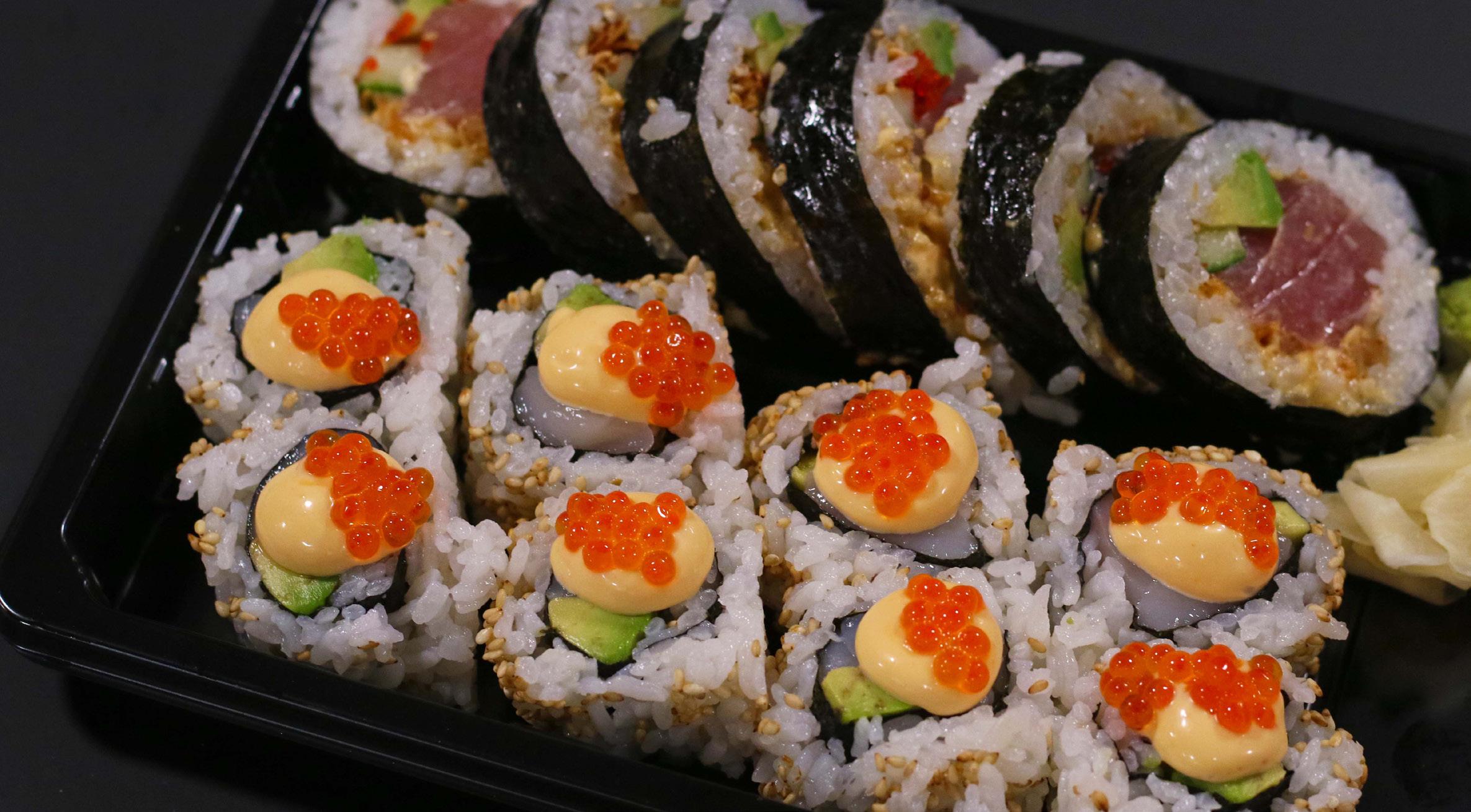
chefs trained at Alex Sushi and Sabi Sushi, a chain founded by fellow Filipino chef Roger Joya; its Stavanger and Oslo omakase branches are the only Michelin-starred Japanese restaurants in Norway. When one of Joya’s assistants, also from the Philippines, ran into visa problems, Quiambao hired him to work in Svalbard. By 2021 the restaurant had an all-Filipino staff, many with experience under either Joya or Cabiao. In 2023 a Thai chef joined the team, “but he’s an honorary Filipino,” Quiambao joked.
Arctic ingredients, Filipino creativity
Quiambao describes Nuga’s sushi as “a combination of Chef Alex and Chef Roger’s techniques”: a style that owes as much to the restraint of Japanese chefs as it does to the whimsy of their counterparts in North America.
The former influence is clearest in Nuga’s nigiri, slen-
Midnight Sun
The Midnight Sun roll, front, is topped with chili mayonnaise and salmon roe in homage to the 24hour daylight that lasts from April to September in Svalbard.
JENNIFER FERGESENWinsley
Quiambao says Nuga’s sushi combines the techniques of Alex Cabiao and Roger Joya, two Filipino chefs who helped establish Norway’s sushi scene in the early 2000s.—NUGA
der parcels that echo the folds of the chef’s palm. Pay attention to the traces of knife work on each piece, like the brush strokes of an artist. Their mathematical precision demonstrates a level of training that few small-town sushi shops achieve. A protractor could measure the acute angle between the cut line and the veins
of fat on the salmon nigiri. The fine cross-hatching on the tuna is like a magic trick, rendering the lean yellowfin as meltingly tender as o-toro.
But even on good days, there are rarely more than four kinds of raw nigiri available — salmon, tuna, salmon roe, and scallop. These return as maki, multiplied like the loaves and fishes


into new forms that stretch the menu to the length Norwegians expect.
There’s the Midnight Sun roll, named for the endless day that stretches from mid-April to late August in Svalbard. It’s a scallop and avocado roll finished with a celestial dollop of chili mayo, salmon roe clinging to the surface like sunspots. The Sukkertoppen roll, whose namesake mountain forms a snow-capped bulwark at the east side of town, is stuffed with equally pallid cream cheese and crab. Other maki can be made even when sushi-grade fish is unavailable, like the baked salmon, boiled shrimp and fried chicken rolls.
Though calibrated to Norwegian tastes, Nuga has managed to attract a Japanese audience. In 2021, the television station TV Tokyo sent a camera crew to “the world’s northernmost sushi restaurant” for a simulcast
on one of the many programs hosted by comedian Hiroiki Ariyoshi. A Japanese-speaking Norwegian guest sampled Quiambao’s sushi while Ariyoshi and a cast of other celebrities watched from Tokyo.
Ariyoshi, known for his “poison tongue,” was lukewarm on the looks of Nuga’s usual sakura set, which includes a salmon roll, a shrimp tempura roll and a selection of nigiri. “That wakame seems a little different,” opined a drag queen guest as Quiambao spooned Kelly-green seaweed salad, a Japanese American invention, into nori to make wakame nigiri.
The station also bought Quiambao reindeer, seal and whale meat so he could prepare an Arctic sushi set for the program. The Tokyo cast perked up when this set emerged from the kitchen. “Kirei (pretty),” they cried as the camera panned the spread, arranged on a slate slab and adorned with antler fragments. “Tabetai (I want to eat it),” they groaned as the Norwegian guest bit into the seal nigiri, each slice of black flesh accentuated by a pearl of green
TVTokyo
The Japanese television station TV Tokyo bought Quiambao reindeer, whale and seal meat to make an Arctic sushi set for a simulcast program.
(The bottom text says: “What are the unique Norwegian sushi ingredients?”)
—SCREEN SHOT FROM TV TOKYO
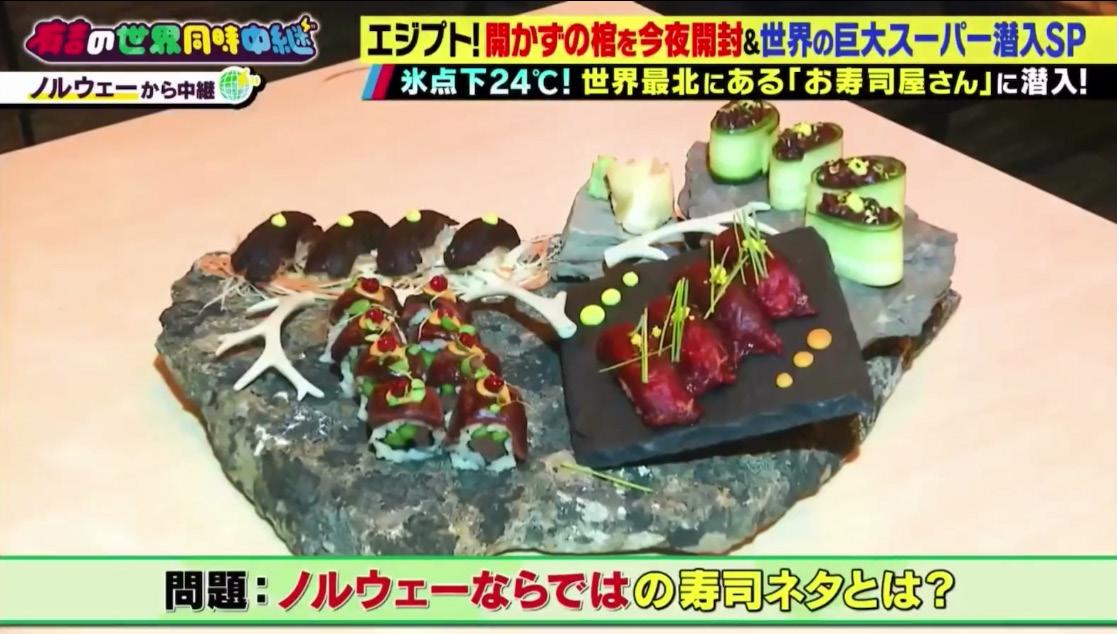
wasabi mayo. Ariyoshi ordered the guest to bring it to Tokyo.
Feeding the community
Quiambao said he enjoyed the TV Tokyo visit, but he’s more focused on serving Svalbard locals. “Some people tell me that they cannot live without sushi,” he said. He has regulars who order without fail every Friday or Saturday, like a religious obligation. Others eat so much when they come that he makes sure to order more fish from his supplier if he sees they’ve booked a table. “Imagine removing that part of their cycle in their everyday life. It would affect the rest of their life too. So it’s kind of a responsibility for me to fulfill that.”
He also finds fulfillment in showcasing Pinoy talent and leadership, both for Norwegians and for young Filipinos in need of role models. The latter became especially important last summer, when his girlfriend’s younger brother died by suicide at the age of 17. The death drew attention to the challenges foreign-born youth face in Svalbard, which lacks accessible mental health care services. It can be easy to feel isolated and out-of-place as a foreigner in Svalbard, especially as a young person, Quimabo said. He hopes his restaurant can be a beacon and an oasis for those who feel lost.
“It’s really important for me to make this a place where Filipinos can go and feel like home,” he said. “The hospitality of Filipinos is really different from other cultures, so I would like to add a little bit of a twist of the Filipino style here where they can feel at home. ... For me, that’s what it’s about, not the money.”
Rai
 Words by Donna Patricia Manio
Words by Donna Patricia Manio
and photos courtesy of Rai Cruz
“Cabinets and Curiosities” could be read as what a mind would be like as a chamber that holds experience, emotion and memories.
“Forsome people, making art is like oxygen to them,” begins Rai Cruz. “I admire such people. They amaze me. Not everyone is and can be like that.” An artist
since childhood, Cruz has successfully made a career in the visual arts, first as a street artist painting colorful visuals in public spaces. His distinct, visceral style led to having commissions and many gallery shows,
including the recent “Cabinets and Curiosities” at Vinyl on Vinyl in Manila.
These days, Cruz lives a well-balanced life in which his art is perfectly imbued: He is a father and husband, an art professor at a university and a jiu jitsu athlete. He draws from all areas of his life to create art, including the pandemic, when his most recent work was conceptualized. “We were all at home,


and so the ideas started from there,” he says. With the isolation came introspection and the inherent need to create and express.
“Cabinets and Curiosities” could be read as what a mind would be like as a chamber that holds experience, emotion and memories. They could be neat and organized — or be like a Pandora’s Box that may be too terrifying to open. It is up to a person’s willingness and bravery to explore all these. Cabi-
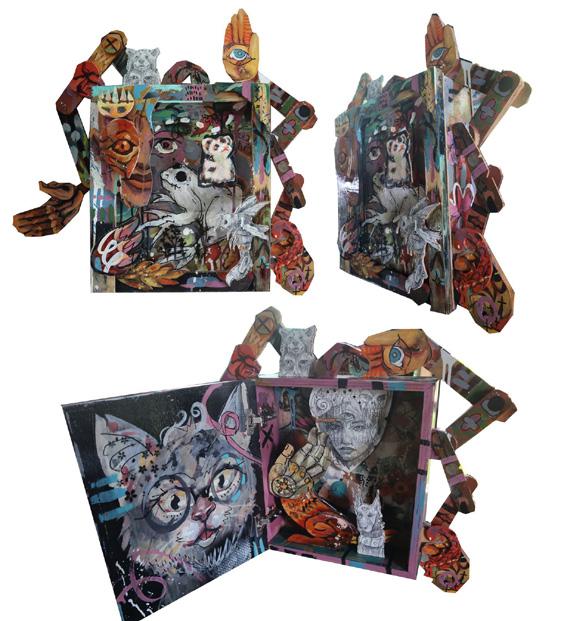
nets are essential as thoughts can get chaotic; there’s always a bid to put everything in order to maintain the cadence of daily life: obligations, responsibilities, routines. But this mode of compartmentalization doesn’t discount the fact that our minds are great repositories of what makes us human. We are, after all, made up of many quirks — or curiosities. This, in itself, is non-linear and rich.
Inspired by his immediate urban environment, Cruz’s
street art, usually murals, sought other modes of execution as his art career progressed to installations, such as the ones featured in his recent exhibit. This is also a welcome evolution as more people become open to street art and those inspired by it. “In the past, people would call it vandalism. These days, they’re more receptive and look at it as art.” Cruz also adds that this mode of art is now embraced by the Filipino mainstream with restaurants and retail stores commissioning murals, seeing the value it adds to livable spaces.
“During the pandemic, people saw that art wasn’t ‘essential.’” Focus shifted to other communities such as service and medical, those that made sure that the world continued to function and operate. “But during the quarantine, I was prompted to create. Most of the ideas were about what the pandemic brought about. Doubts about the future, anxiety.” For the artist, creation and expression were necessities, a way of capturing an extreme and uncommon experience. Creating is synonymous to living, the artist shares.
Now that we are living in the next normal, what was once in the artist’s figurative cabinets are now available to be viewed and enjoyed. Cruz points out that life is vast and deep. Like everyone, he goes on with his day-to-day: making memories as a husband and father, learning new insights from his students, and fighting for focus through jiu jitsu. There will always be something new to learn and see. There will be alternative ways of thinking and growing, and therefore, more to keep as eventual curiosities.

In the heart of Europe lies a small but very important EU founding member; the Grand-Duché de Luxembourg. Nestled in the middle of France, Germany, and Belgium, this landlocked country is considered the richest country in the world by GDP per capita (Forbes Magazine 2022/Global Finance Magazine 2024). It is also home to the town of Schengen, where the Schengen Visa agreement was signed paving the way for visa-free travel among Schengen-member states. This country is rich in heritage and culture, being at the crossroads of French,
German, and Belgian cultures.
This year, after more than a century, the operetta “An der Schwemm,” a Luxembourgish cultural treasure, has been revived by Opera Mobile, co-produced with Escher Theater, Centre des Arts Pluriels Ettelbruck, Festival de Wiltz, INECC Luxembourg and Maskénada. It is also supported by the Ministère de la Culture de Luxembourg, Fondation Indépendance and SACEM Luxembourg in collaboration with Fraen en Gender, Sequenda asbl, and Centre National de l’Audiovisuel. This operetta was created by Luxembourgish composer Lou Koster in 1922 and libretto by journalist Batty Weber. The story revolves around Lory, a confident swimmer who resists the advances of the official Zengerlé in the swimming pool and falls in love with the soldier and swimming instructor Reddy. The swimming pool was the melting pot of social life in the 1920s.
The hall of Escher Theater was captivated by the marvelous performance of this short operetta on January 27 and 28. It was followed by another performance at Centre des Arts Pluriels Ettelbruck on February 3 and 4. Stage direction was excellently executed by Marion Rothhaar with her assistant director Laetitia Lang, and the superb musical direction of Maestro Jonathan Kaell with the Orchestre de Chambre de Luxembourg brought life to this cultural gem. The audience were brought back to the 1920s, thanks to the genius stage setting and costume design by Peggy Wurth and the marvelous hair and makeup by Joël Seiller and Valentina Becker.

The difficult 20th century musical passages at the start of the operetta were given justice by the velvety soprano voice of Valérie Stammet, who played Lory, and the soaring tenor voice of Loïc Schlentz, who played the hunky swimming instructor, Reddy. The audience were mesmerized with the beautiful ariettas sung by Lory (Ms. Stammet) and Reddy (Mr. Schlentz). The lively and catchy song of Zengerlé, sung by baritone Christophe Bornet, kept many humming the tune even after the performance. Complementing the main cast are equally brilliant actors Marie Mathieu, Julie Colin, Luc
Lamesch, and Misch Gessner. Adding layers to this wonderful operetta is the INECC Choir, composed of Cipriano De Guzmán Jr., Julien Ardouin, Julie Colin, Mària Devitsaki, Sandrine Garçon, Marie Mathieu, Henrik Mazur, Amandine Moutier, and Michèle Turpel with choir direction under Andy Loor and choreography by Gianfranco Celestino.
The operetta will be performed again on June 29 at the oldest and most traditional festival in Luxembourg, the Festival de Wiltz.
*the author of this article is one of the performers in the operetta “An der Schwemm”.



“The journey to achieving gender equality is perhaps still long. However, every step that each of us take in showing our capabilities as women makes us powerful agents of change.”
Words by Rhodaliza Steegmaier
Photos courtesy of Cerelina Ernst, Carla Macasero, Susana Hauck
In celebration of the National Month of Women, the Philippine Honorary Consulate in Stuttgart interviewed three Filipina nurses in Stuttgart, Germany who have been working in caregiving and senior homes. We traced their professional journey which led them into their current designations as heads of their respective teams. Meet Cerelina, Carla and Susana, three outstanding women who have certainly proven their capabilities as women, embodying this year's Women’s sub-theme “Lipunang Patas sa Bagong Pilipinas: Kakayahan ng Kababaihan, Pa-
tutunayan.”
Cerelina Ernst came to Germany after marrying a German national, while Carla Macasero arrived in Stuttgart in 2022 as one of the nurses under the Triple Win Program (TWP) nurses hired by Wohlfahrtswerk für Baden-Württem berg, a caregiv ing home where both Carla and Cerelina are working.
Susane Hauck, on the other hand, used to be a nurse but now runs her own intensive home care ventilation company called Pinoy Pflege.

Programme in 2019. Through this program, we were given the opportunity to choose between caregiving (Pflegeheim/ Altenheim) or hospital (krankenhaus) and I chose to work in a caregiving home. At that time, there were 15 nurses under TWP, and we were deployed to various facilities of Wohlfahrtswerk in Baden-Württemberg. I was assigned to Haus am Weinberg. Weinberg in English is a vineyard and so, where I work, I have a nice green view of a grape vineyard.
What brought you to Germany, and how did you start in your current job?
Cerelina: Like most Filipinas in Germany, love brought me to Stuttgart in 1993, and I am still married to my German husband until now. I am actually a chemical engineering graduate, but knowing that the recognition of my profession would take a long time due to the different school system between Germany and the Philippines, I decided to venture into an alternative option to get a job and tried caregiving. After six months of intensive German language courses, I was given the chance to work at Haus am Kappelberg, a home care facility in Fellbach near Stuttgart, under Wohlfahrtswerk für Baden Württemberg. I started as an assistant nursing aide and all-arounder.
Carla: I joined the Triple Win
Susana: Like Cerelina and Carla, I also started as a registered nurse working for a nursing home from 2001 to 2009. I would say that my transition to specializing in intensive home care ventilation in 2010 led to a focused journey of establish-
ing my own company in February 2021. The good rapport which I have established with patients, coupled with encouragement from their relatives, somehow motivated me to be an entrepreneur and start my own business.
What were the initial challenges you had to face in doing your job or in starting your business?
Cerelina: At first, I really had difficulty communicating with the elderly and with my co-workers in German language, especially since some of them speak in Schwäbisch dialect. But the work itself, giving assistance to the elderly, was very fulfilling, and I loved it.
Carla: There were so many challenges that I had to face when I started working here in Germany. First is the language barrier even if I already have a B1 language certificate. Without the complete integration and understanding of the German language, it was really

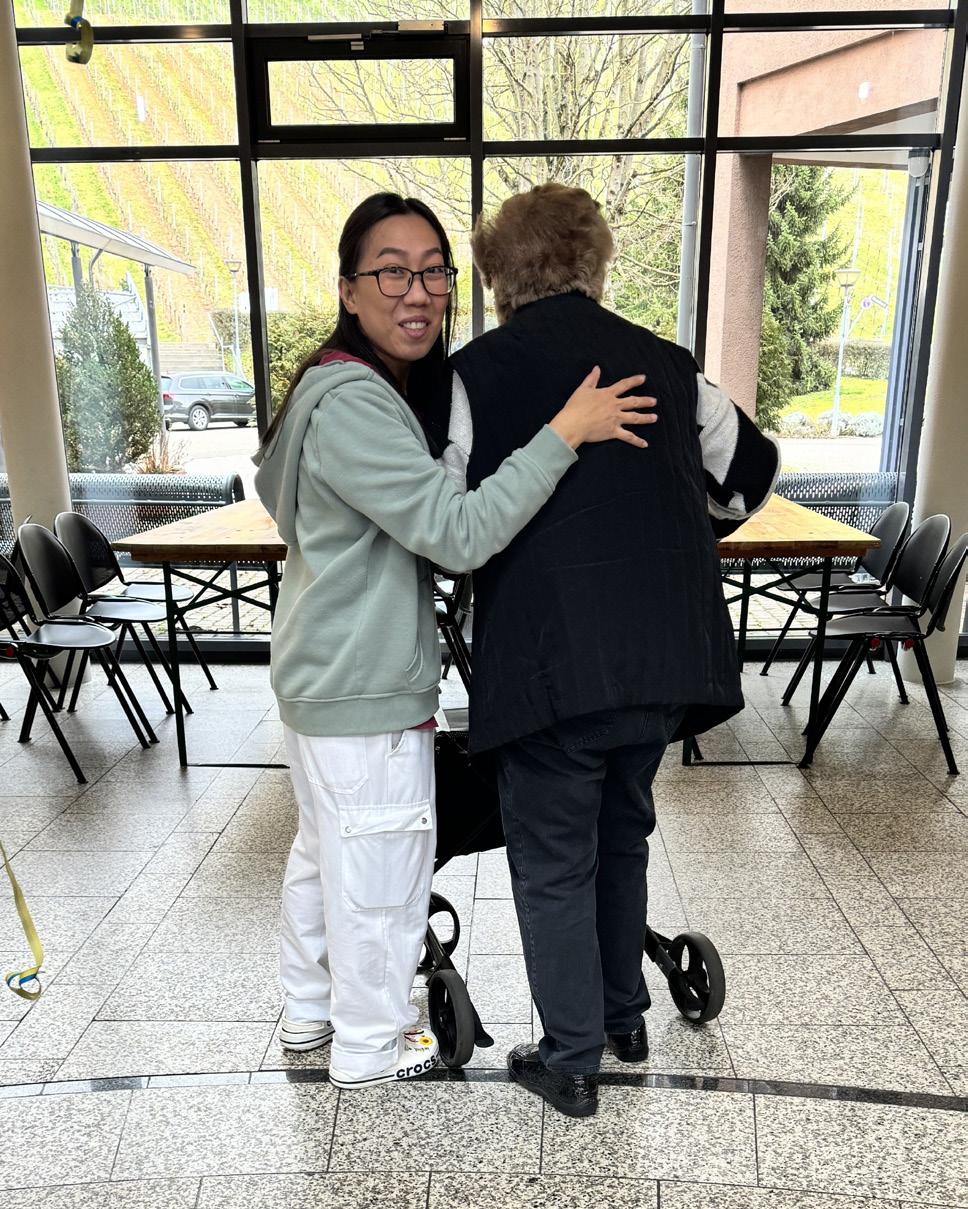
hard for me to deal with daily work situations. Secondly, we are working and attending our B2 language classes at the same time. The language course is needed before we can secure the recognition certificate as a nurse or the so-called Anerkennungsurkunde. So time management and balancing everything was a big problem. Third is the German culture because it is way different from the Filipino culture, such as being so direct. Filipinos try to be polite and we like to sugarcoat our words. The Germans don’t mince words and just say it directly. No is No, and Yes is Yes, no Maybes and Perhaps.
Susana: The language barrier, the complexities of being a foreigner and, believe it or not, being a woman added layers of difficulty in starting my business. Some people were skeptical, doubting my ability as a Filipina to establish my own company. It is, indeed, difficult to navigate through all the requirements and licenses to
comply with the German business regulations. Thankfully, my ex-husband supported me in overcoming the initial obstacles of starting a business.
How long did it take before you got the designation as a team leader and since when have you been holding the position?
Cerelina: In 2000, I think my supervisor saw a potential in me and pushed me to pursue a degree in geriatric nursing. Right after I got my diploma in the year 2003, I was appointed as station head. Then I was promoted thrice in a span of four years after serving 10 years as station head.
In 2013, I was promoted to key account manager. In 2014, I was appointed as deputy head of nursing services. In 2016, I became head of nursing services, where I completed my nursing services management course simultaneously. In 2017, I switched from home care facility to outpatient nursing care, still under Wohlfahrtswerk. I was convinced by the management to manage one of the three branches of Mobile Dienste Wohlfahrtswerk, or Mobile Caregiving Service, located in Fellbach up to the present. Also in 2017 and again in 2021, after the pandemic, I was involved in recruiting Filipino nurses for our company Wohlfahrtswerk through the Triple Win Program. Actually, Carla is one of those we hired in 2021. I was
with my HR head in Manila and did the interviews. Just last September 2023, I celebrated my 30th year working with Wohlfahrtswerk.

Carla: I received my certificate or Urkunde as health and caregiver (Gesundheits und Krankenpflegerin) last October 2022. Then in March 2023, or five months later, I was promoted as head of the residence area or Wohnbereichsleitung. According to my superior, I was the first non-German employee in the facility to be given the opportunity to take on the title without requiring an extensive work experience. I also received a lot of recommendations from colleagues to take on the task when the position was opened. I was really surprised that the designation was given to me, considering I have only been with the Home for less than two years at that time. Then in December last year, I was given another big opportunity to be the alternate caregiving head or sub-team leader. It is a preliminary stage to becoming a full-fledged team leader for the entire caregiving home, but I still need to do some workshops to acquire the exact qualification of getting the title as Pflegedienstleiterin or PDL.
Susana: It took me about 20 years starting from the time I started as a registered nurse until I opened my own company in 2021. I am proud to say,
however, that my son Marcel is now diligently working as the CEO of the company and is just as equally at the helm of managing the company as I am. I could see his commitment to the company’s values and goal in the decisions he makes. Together, we are steering the business forward and his contribution adds a familial touch to the company, making it a true family endeavor rooted in dedication and shared vision.
What are the usual challenges that you have to deal with?
Cerelina: As head of this branch, I have to deal with all kinds of challenges. I have to ensure that smooth operation of the branch is maintained, make plans and strategies in advance to cope up with competing agencies. I have to deal with our clients and their families’ wishes and suggestions on areas for improvement. I also have to deal with the patients’ family doctors, personal caretakers, health insurances, medical establishments, and also internally deal with my seniors and my staff, among others.
me is dealing with all the complaints from residents, relatives and, at the same time, from some other colleagues. In a place where people of different races and ages work together, those are to be expected.
As a PDL, I have to remind myself to think of a solution to the problem which will not cause any harm to either the residents and the facility itself. Bringing my emotional Filipino attitude is a challenge for me because, here in Germany, one has to be firm with any decision you make. You can’t be wishy-washy.
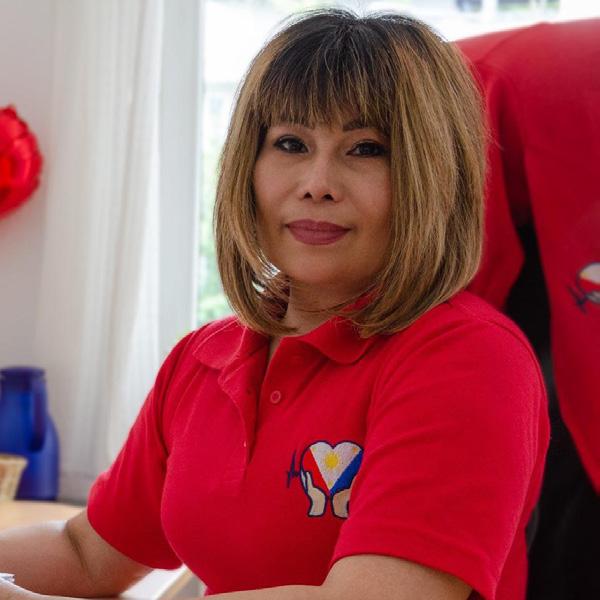
Carla: The PDL carries out administrative and organizational tasks, such as personnel planning, organization of schedule and monitoring compliance with quality standards. We are also the contact person for residents, relatives and employees.
One of the big challenges for
Susana: Addressing the patients requests and complaints is part of the usual challenges. Patients’ expectations about the staff’s German language proficiency occasionally arise. Some patients, however, speak in German dialects, which admittedly are sometimes difficult to understand in the same manner that some patients also could not understand the way our Filipino nurses pronounce German words. In such cases, I consistently try to encourage our patients to give our team members a chance to show their capabilities. Likewise, I also encourage my team to understand the peculiarities of each of our patients.
Do you have Filipino/Filipina nurses in your team, and how do you manage them?
Cerelina: I have mixed-race nurses, and I am very lucky
and proud to have three Filipino nurses and one Filipina-German with me in my team. As their head, I make sure to give them a good atmosphere and a harmonious environment to create and maintain a strong team spirit. I give full attention to their personal problems when they share them with me.
Carla: Yes, there are some kababayans and also those from other countries in the facility where I am. Handling the complaints of colleagues is also not easy and I always have to find some compromise, even if my decisions sometimes make me unhappy. But, as a leader, I have to make unpopular but objective decisions and that is never easy.
Susana: Having Pinoy Pflege as our company name, we, of course, have a number of Filipino and Filipina nurses in our team and I’m happy to have all of them. When improvements are needed in terms of serving our patients better, I confer with my team not as a superior but as a mentor and a friend. I make an effort to maintain an approachable demeanor and avoid showing a bossy attitude. Showing respect is the cornerstone of my interaction with the members of my team.
What are some of the support services you provide to the Filipino nurses who get hired by the company you work with?
Cerelina: I did mention that we hired Triple Win Nurses back in 2017 and 2021. I am thankful that the Philippine Honorary Consulate in Stuttgart headed by Honorary Consul Dr. Axel

Neumahr has taken the initiative to give a welcome reception to our Filipino nurses, serving them Filipino food and even cooperating with some of the German companies such as the Welcome Center in Stuttgart which, for its part, generally assists new settlers in Stuttgart. Everytime we hire new TWP nurses.
Carla: Yes, we really appreciate the efforts of the Philippine Honorary Consulate in Stuttgart and the Filipino Nurses Community in Germany (FNCG) in welcoming us shortly after our arrival in Germany. I remember we had an “outdoor” reception as there were still pandemic restrictions in effect at that time. We also appreciate the support of the Filipino community who shared with us some of the winter clothes and other home items they no longer needed to help us get started with our new life in Germany. Indeed, Bayanihan is very much alive in Stuttgart and in most parts of Germany.
Susana: Occasionally, there are events organized by the Fil-
ipino community groups such as the Filipino Nurses Community in Germany and some other Filipino organizations in Stuttgart where we get to promote Pinoy Pflege by way of sponsorship. Joining public events on awareness of the existence of our company and we get the opportunity to talk about the distinct caregiving services that we offer.
Any words of wisdom you would like to share with our nurses in Germany and other parts of Europe?
Cerelina: I only hear warmth and praises from other medical establishments and former patients and their family members about Filipino nurses. So keep going with the good deeds, good performances and tender-loving-care attitude at work and off work as well. Mabuhay!
Carla: My advice is to accept all challenges with a smile. My own experience has taught me that. At first, you may doubt yourself if you can do it but, believe me, “what ifs” are worse than saying to yourself
“I tried.” A bad decision is better than indecision. I know it is hard to stay positive all the time, but always keep in mind that what you manifest is what you will attract. So always give your best shot and only positive things can come out of it. Try looking at all the brightside in all the challenges, whether at work or in your personal life.
Susana: Eleanor Roosevelt once said that “A woman is like a tea bag — you can’t tell how strong she is until you put her in hot water.” Starting one’s own caregiving business or any business for that matter is taking on calculated risks. Surely, there will always be challenges in anything we do and it only takes courage and conviction from one’s self to surpass them. One just has to believe that there is nothing we can’t do as a woman. Indeed, women as leaders and decision-makers at all levels, no matter whether in private or public offices, are critical to advancing gender justice and gender equality — and to furthering economic, social and political progress for all. The journey to achieving gender equality is perhaps still long. However, every step that each of us take in showing our capabilities as women makes us powerful agents of change. So let’s continue to show what we can do because we are women (Babae ka!) and never allow anyone to tell us we are just women or “Babae ka lang!”
*The Triple Win Program (TWP) is a government-to-government project which started in 2013 and is based on an agreement between the German Federal Employment Agency (Bundesagentur für Arbeit) and the Philippine Overseas Employment Administration (POEA) on the procedure, the selection and the placement of nursing professionals.


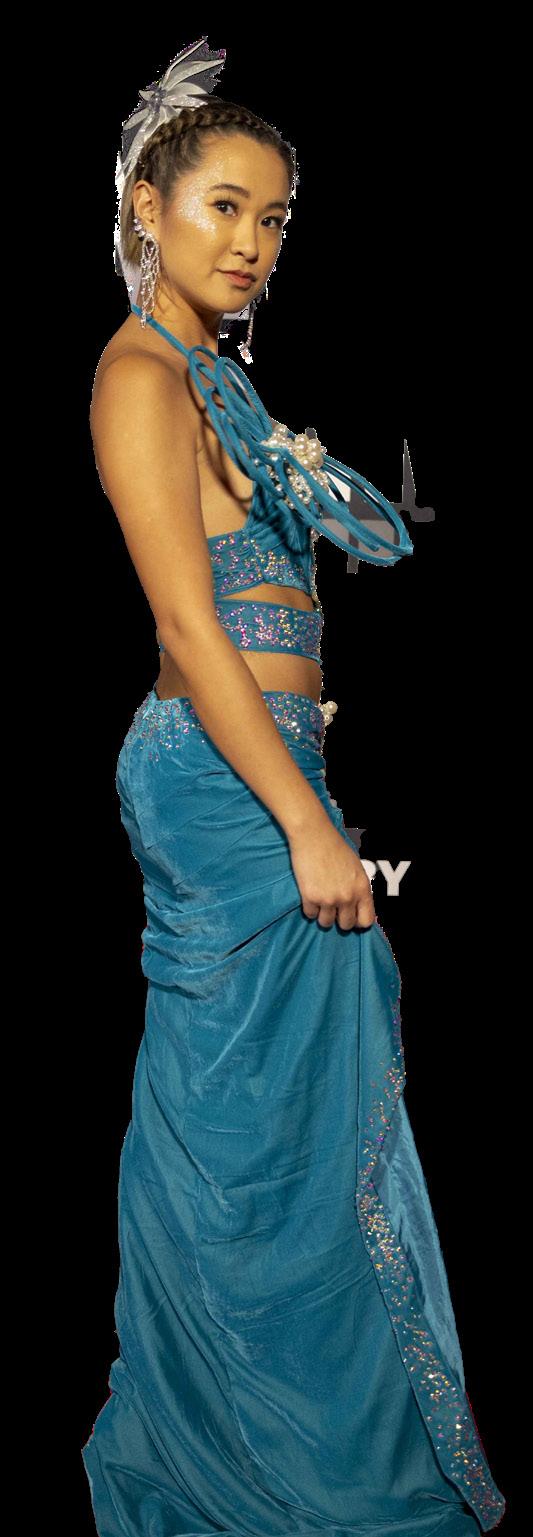



 Words by Mye Mulingtapang
Photos by Ryan Arbilo
Words by Mye Mulingtapang
Photos by Ryan Arbilo
From the initial chapters of her life, spent amidst the verdant fields where Chona Bacaoco diligently traded vegetables at the bustling Guimaras public market, a narrative of resilience and transformation began to unfold. This journey, rich with humble beginnings,
has seen her metamorphosis into the prestigious role of MM Milano’s chief designer. With each stitch and fabric choice, she interlaces her personal experiences and deeply rooted values, creating garments that transcend mere fashion and become poignant reflections of her extraordinary journey.
Bacaoco faced the sting of exclusion and undervaluation, a contrast to the soaring
heights she now occupies. Her story has placed her at the helm of an empire that extends beyond mere professional realms — it is a sanctuary she calls home. Within these walls, a culture of collaboration flourishes, a haven where kindness, respect, compassion, integrity, and inclusivity intertwine seamlessly, crafting a distinct ethos in the fiercely competitive world of fashion.
The genesis of her passion can be traced back to the very heart of her mother’s tailor shop. This early exposure became the catalyst for a lifelong devotion to the craft, propelling her towards the discovery and nurturing of models and talents who now proudly represent her company and contribute to the growth of sustainable emerging brands.
In delving deeper into the tapestry of Bacaoco’s narrative, one finds a story marked by resilience, creativity, and an unwavering commitment to her roots. It is a testament to her ability to transform adversity into triumph, embodying the spirit of a true artisan who not only creates fashion but etches chapters of her life onto every garment.
Bacaoco’s journey reflects her inherent qualities and strengths, refined through experience and perseverance. Transitioning from managing client relations to crafting tailor-made gowns showcases her flexibility and determination. Her adeptness in handling clients and casting models underscores her interpersonal skills and discerning vision. Organizing fashion shows with grace and precision demonstrates her comprehensive skill set and innate understanding of event dynamics.
In designing exquisite gowns, Bacaoco’s artistry flourishes, with each creation becoming an intricate expression of emotion, culture, and craftsmanship. Her ability to meet diverse clientele demands highlights her keen understanding of individual
tastes and cultural nuances.
Collaborations with globally renowned designers like Michael Leyva, Albert Andrada, and Michael Cinco symbolize the recognition of Filipino talent on the international stage. Events like the Cannes Film Festival amplify her creative voice, showcasing the influential impact of Filipino craftsmanship in global fashion. Bacaoco’s success is a testament to her dedication and commitment to excellence in every facet of the fashion industry.
Driven by the fundamental question of “What does my community need?” Bacaoco’s brand, HOME by MM Milano, embodies her commitment to inclusivity. Rejecting age, color, race, religion, and politics as barriers, HOME transcends mere fashion to become a global movement celebrating diversity.
Bacaoco’s role extends beyond that of a designer; she

is the visionary architect of an inclusive empire challenging traditional fashion norms. Within HOME, values and talent hold equal significance to aesthetics, fostering a harmonious blend of creativity and ethical principles.
Her approach fosters a community where inclusivity is not just a concept but a lived reality, erasing boundaries and celebrating humanity. This community serves as a beacon, advocating for harmonious coexistence within the fashion industry.
In this space, playfulness reigns supreme, infusing the creative process with empowerment and collaboration. It highlights the belief that fashion should reflect the diverse voices contributing to its narrative.
Moreover, Bacaoco’s commitment to kindness forms the foundation of her brand, transcending fashion to reshape industries and societies. Her journey from identifying community needs to creating
HOME by MM Milano speaks volumes about the transformative power of fashion, redefining contemporary fashion’s essence through inclusivity and diversity.
Love Woven in Fabric
Renowned for her particular style, which is defined by voluminous and dazzling costumes, her creations are more than just garments; they are evocative narratives that dig into the complexities of womanhood while expressing her

quirky personality. Each dress transforms into a canvas embodying femininity codes linked with her personality thanks to masterful textile play and beautiful embroidery.
Exploring the delicate interplay of fabric and embellishments, Bacaoco showcases not just her technical prowess but also a deeper layer of artistry. Carefully chosen fabrics, strategically placed, metaphorically unveil one’s inner self, peeling back layers to reveal

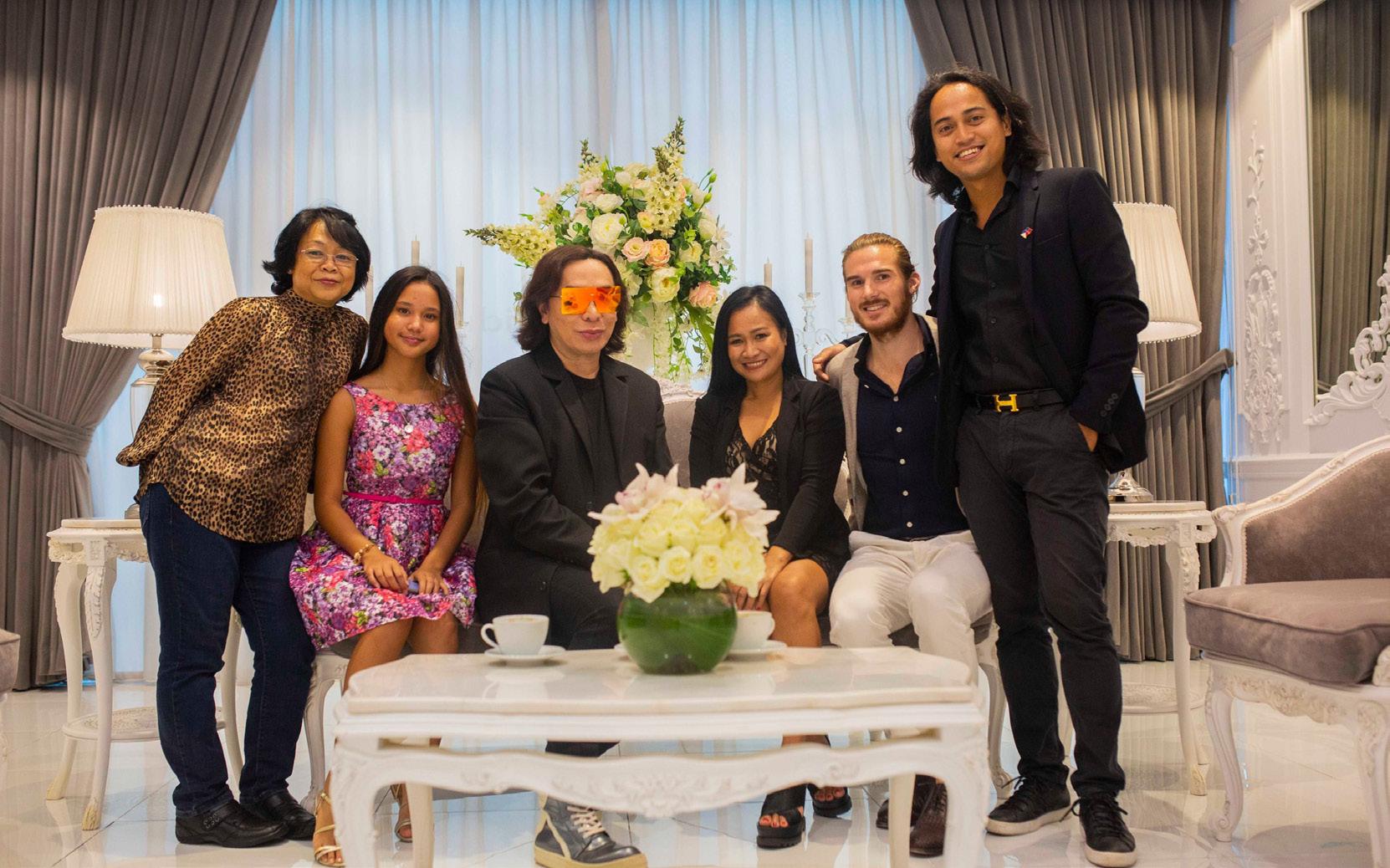

vulnerability, strength, and resilience. The meticulously crafted beading embroidery is more than decoration; it manifests intricate emotions and experiences shaping her journey.
Bacaoco’s recent presence at the Cannes Film Festival marks a remarkable chapter in her brand’s evolution. Designing dresses for Italian celebrities and VIPs like Gucci heiress Drusilla Gucci, at this esteemed event showcases her journey from beauty pageants to global cinematic glamour, highlighting Filipino talent’s capacity to shine on the international fashion stage. This significant foray demonstrates her ability to expand horizons and excel beyond traditional standards, solidifying her position as a notable figure in the fashion industry.
Launching her own line, Chona Bacaoco Milano, during New York Fashion Week at the iconic Angel Orensanz Foundation represents a milestone moment. Her latest collection, “Shooting Stars,” debuted with 25 pieces designed to transcend age barriers and cater to a diverse clientele. Using traditional Philippine fabrics like hablon and piña infused with a modern touch, Bacaoco blends heritage with contemporary design, offering a unique fusion appealing to a global audience.


Bacaoco’s journey, from humble beginnings on the island of Guimaras to international fashion stages, resonates deeply with her metaphorical portrayal of dreamers as shooting stars. Her rapid progress echoes her father’s philosophy, “time is gold,” infusing her endeavours with dynamism and purposefulness. As she takes centre stage, her collection becomes not only a manifestation of design but an expression of her journey, philosophy, and commitment to inclusivity, illuminating the boundless possibilities for those who dare to dream.


The hybrid world of art and cultural diplomacy is a powerful tool to achieve sustainable peace.Words by Gloria Hernandez
Meet Regine Borja Guevarra, an ambassador, a leader, an advocate, an entrepreneur, a polyglot, and a fashion enthusiast. Name it and she has it all. A well-rounded individual aptly suits her description.
Regine is a certified citizen of the world. She has Jewish
heritage; her ancestors were Chinese and Spanish Jews. She speaks English, Arabic, Hebrew, Spanish, Japanese, Bahasa Malaya, and started learning Russian, too. She has foreign education; she earned her master’s degree in Coexistence and Conflict Resolution from the Brandeis University in Boston and completed the Program on Negotiation at the Harvard Law School. She took her bachelor’s degree in AB Devel-
opment Studies at the Ateneo de Manila University.
But more than her attributes, Regine remains humble and philanthropic. Her advocacies aim to promote human rights and social consciousness like peace, love for the environment, and global citizenship. She believes in “the Divine Order” and “putting oneself in the highest intent results in the highest good.”
She continues to look back at her grandparents’ modest beginning from a farming village in Bicol, who she said, “have worked their way up to become industrialists and cultural beacons.” They founded the Radiowealth, the GUEVENT, the Guevara Foundation, and the Ikebana Foundation of the Philippines. Her grandparents’ love for farming also inspired the foundation of the Farmacy Haven.
Her late father was her business mentor while her mother, a former beauty queen and award-winning fashion producer, continues to be her moral compass. Her parents inculcated to her the deep love for country and humanity. She manages the family’s real estate business.
Her pursuit to become a leader started at an early age when she ran as a member of the student council and a member of the Sangguniang Kabataan (SK) at their local community. She explored her global opportunities after her university studies. She had her internship at ONE Singapore. As an advocate of peace, this was an opportunity that further hastened her desire to champion peace.
The International Human Rights Commission has recently designated her as the Goodwill Ambassador-Designate to the Philippines; she is actively participating in its various programs promoting rights of women and children, peace, justice, and other humanitarian issues. She is also part of the Secretariat of the UNESCO International Theatre Institute in the Philippines.
A recipient of the Global Youth Icon, Regine founded the volunteers wing of the Committee for ASEAN Youth Corporation based in Malaysia and represented youth organization at the UN Interagency Network on Youth Development, UN Major Group for Children and Youth, Global Coalition in Youth, Peace, Security, and Asia Pacific Interagency Network on Youth.
genres, from Morocco, Africa, Asia, and the rest of the Global South.”
She recently produced a fashion show, in cooperation with the Philippine Embassy in Morocco, at the King of Morocco’s Royal Mansour Mansion in Marrakesh. She presented the works of designer Azizah Talusan of Cotabato City, the founder of HersLaha. She believes that “elegant design goes beyond mainstream fashion weeks.”
We want to provide a venue for rising artists where they can showcase their talents and creations and help them develop networks of market and connections globally
She channels her passion and enthusiasm in art and fashion by producing shows in the country and abroad. She is the producer at the Asia TV Studios, the platform she uses to promote her advocacies through art, music, and fashion locally and internationally. She is one of the founders of the CreatiVerse, an organization that “brings together creative industries across
She facilitated the exhibit of French organic painter Savid G, produced the musical show of Brazilian DJ Jose D in Siargao island, and manages the career of international artist Xander Pratt.
“We want to provide a venue for rising artists where they can showcase their talents and creations and help them develop networks of market and connections globally,” she explained and stressed that “we aim to promote and co-create spaces for them to freely express themselves while finding deeper purpose in the way they communicate to the world.”
“The hybrid world of art and cultural diplomacy is a powerful tool to achieve sustainable peace,” she says.
 Words by Ieth Inolino-Idzerda
Words by Ieth Inolino-Idzerda
If you’re reading this, you are most likely someone living or working abroad. It’s no secret that life overseas can be daunting, overwhelming and confusing. You are not alone. There are 1.8M overseas Filipinos as of Q1 2023.
Seeing that there is a clear knowledge gap in preparing
Filipinos for a life overseas and to integrate effectively, Donna Avellana Künzler drew from her learnings and personal experiences from years of living overseas across three continents, four countries and five cities to write and self-publish The Overseas Fabulous Pinay: A modern Filipina’s handbook on how to thrive abroad in 2020.
Although not limited to female readers (male readers can definitely pick up a thing

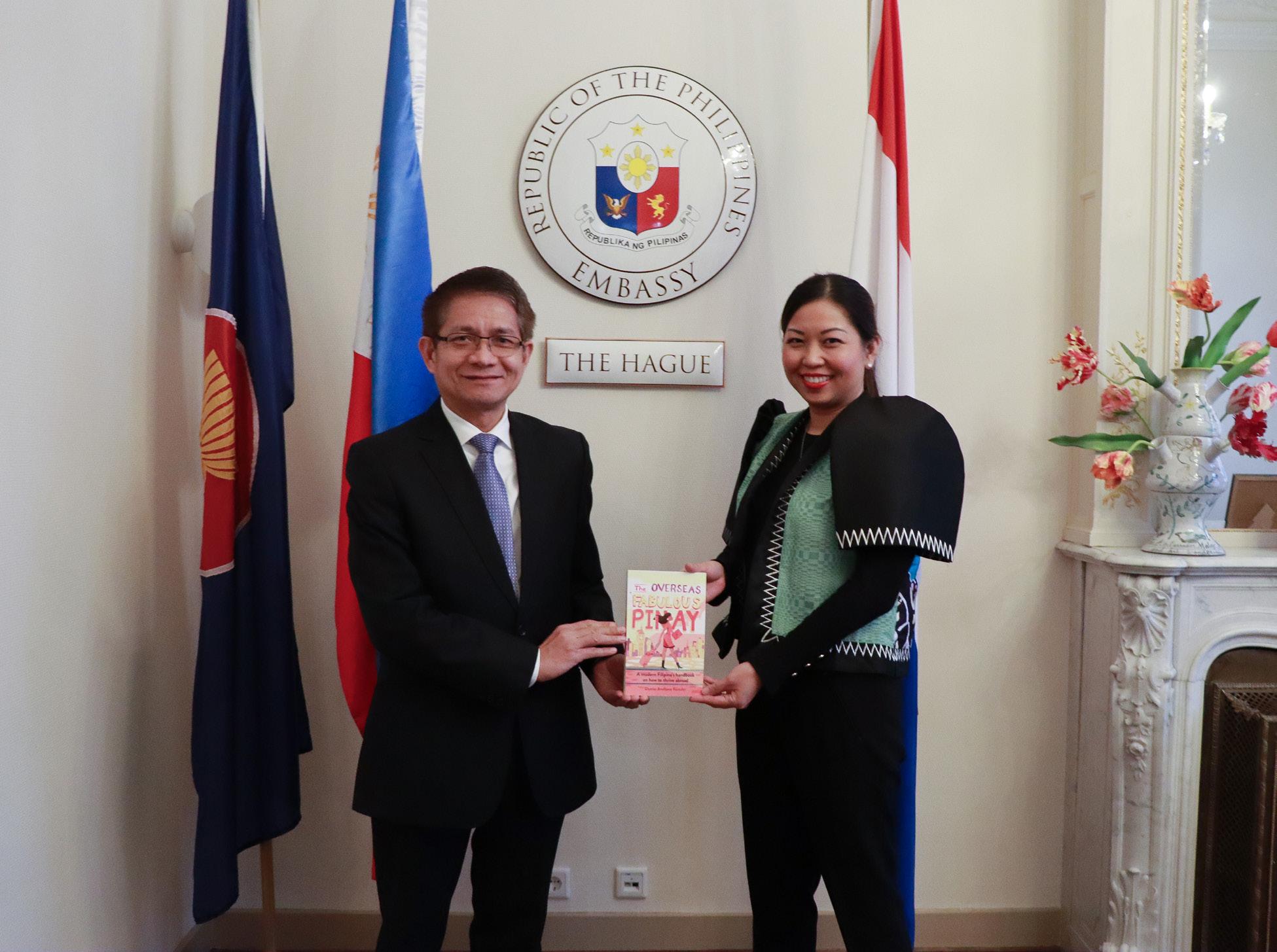
or two), this comprehensive, easy-to-read and light-hearted handbook is full of guidance and practical tips to survive life abroad, from planning an overseas move to integrating in one’s host country while being confident, sophisticated and responsible.
Künzler, who is also Roots & Wings’ Swiss country editor, is bringing her inspiring stories to different cities in Europe including The Hague. The Philippine Embassy in the Netherlands hosted its fourth book forum February 2, 2024 featuring OVFabPinay (as the book is fondly called). Entitled “Thriving as a Filipina in Diaspora,” the event was in partnership with Yugto Book Club, whose founder, Rotter-
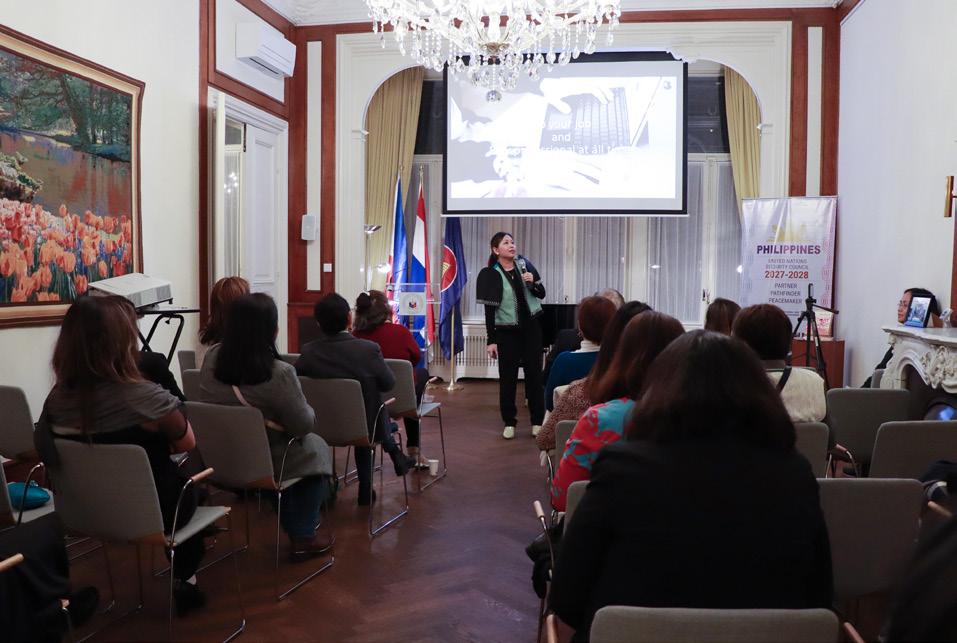
dam-based Filipina Angeline Calleja, moderated the forum.
In his opening remarks, Ambassador J. Eduardo Malaya cited the importance of community building and engagement. “We need to inspire and learn from each other and be an empowered communi-
ty,” he said. This resonates with the stories of Filipinos and Filipinas who moved to a new country to start a new chapter in their lives, embracing opportunities and making a mark wherever they are in the world.
To get a copy of the book, visit https://ovfabpinay.com/. To connect with the community of Yugto Book Club and learn more about its advocacies, visit https://linktr.ee/yugto. For more information about The Philippine Embassy in The Netherlands, visit thehaguepe. dfa.gov.ph..
Arlo Jake Lagmay is a visual artist and architect based in Basel, Switzerland. He debuted as an emerging contemporary artist last year in a duo exhibit called “Audacious” at Eleven Ten Studio in Basel and has participated in the prestigious Florence Biennale 2023. He kicked-off 2024 with “Balintatao,” his second solo exhibit at Waldhaus Am See in St. Moritz, Switzerland and has more exciting events lined up for the rest of the year.
Triggered to be an artist
Lagmay was born and raised in Cordon, Isabela. For as long as he can remember, he has always been drawing faces of people, mainly women. When he was still in school, his artworks always got selected by teachers to be displayed, and he even commissioned some paintings to teachers and classmates.
Lagmay pursued architecture as his main profession and worked for five years, until his passion of becoming an artist was reignited when he moved to Basel in 2018.
“I always wanted to visit and live in countries that none of my colleagues have ever visited, so even if I managed


to land a similar job position in Singapore for over a year, I always aimed to get a job in Europe,” he says. “As I was planning my itinerary for my European summer holidays back in July 2018, a Swiss engineering company invited me for an initial Skype interview. I proposed to have a face-toface interview as I will be in Switzerland that day. Almost one hour after the interview, I got the job, and the company gave me a month to move to a completely new environment, a different continent. From there my life changed drastically.”
The universe seemed to have lined up the stars for Lagmay, as of all the places in Switzerland, he ended up in Basel, its cultural capital. It is famous for its many museums,
including the Kunstmuseum, Fondation Beyeler, Vitra Museum, and every year hosts the famed Art Basel. The latter’s website describes it as “the leading global platform con necting collectors, galleries, and artists.”
When Lagmay saw the collection in Art Basel 2019, something inside him stirred. With some annoyance, he recounts, “They were not thought-provoking, they don’t support current events or political arguments. They don’t have anything like that, or at least not as much. And given that it’s one of the biggest art fairs in the world, it lacked some essence.” It has never been clearer for Lagmay that it’s time to
enter the art world at an international level.
Debut year as an international visual artist
Driven by his goal to finally go mainstream, Lagmay started the work to prepare his art pieces to show to various galleries. What is his creative process like? Lagmay explains, “I relate my art to an organism; it must develop spontaneously. But it always starts with an idea. Paraphrasing Leonardo DiCaprio’s Dom Cobb character in the movie Inception, the smallest idea can grow to define and destroy anything. My idea always starts developing from my thoughts, and it always argues its authenticity and organicity to me before I even decide to sketch it. From there, I enter my studio, grab whatever painting medium I feel like using, put ‘On the Nature of Daylight’ by Max Richter on the background and start giving the face of the idea.”

Finding his distinct style was paramount. When asked about his style, Lagmay describes, “Some see pop art in them, and some see it as a marriage of contemporary and realism. But to me, my art mirrors myself, my thoughts and gives face to my reality. In a more technical sense, my art is all about juxtaposition of extremes. Black and white, good and bad, right and wrong, and chaos and order. I also go as far as mixing opposing media and styles. I do not use color wheels to align with a specific taste or norm, because I do not want to conform or be told what to do or not. My art is a version of
my reality, and reality creeps like an organism, illimitable, irregular, unstoppable.”
And did he ever doubt himself while in the process of establishing himself as an artist? Lagmay thoughtfully recalls, “Given different styles and varieties of legendary artists, for some time I have doubted myself. But that doubt went away almost entirely. When I finished painting “The Swiss Points of View,” I found myself staring at it, crying. It felt like a mirror. It is a mirror. I always believe that it is one’s internal conflict that makes one unique and stand out. And when I saw myself in that painting, this conviction of hoping to be a notable artist suddenly became very possible.”

ence Biennale. When asked about it, Lagmay joyfully recalls, “That was not planned at all. Parang suntok sa buwan! At one point, I was feeling a bit low, really negative as I was not sure of how to maintain the momentum of these exhibits. Then I saw the advertisement online for Florence Biennale, and surprisingly the theme fits my collection’s theme which is ‘I AM YOU.’ I had a surge of emotion right there and then, and maybe within 30 minutes, I spontaneously decided that I would apply, then gathered all the requirements and submitted my application. The deadline was actually the next day. I always believed in this spon-
Last spring, Lagmay held his first international exhibit as part of a duo exhibit aptly titled, “Audacious” at Eleven Ten Studio in Basel. The gallery claims that it’s one of their most successful exhibits to date. Lagmay held four more exhibits last year, including a first solo exhibit and his participation in Florence Biennale.
That is a pretty impressive record for an artist’s debut year, especially by being able to participate in a very prominent event such as the Flor-

taneous feeling. When you get it, you just have to do it. And that’s when I’m most effective — I know I can give my all. It always just works seamlessly every time I have opportunities like this. I can feel it like it’s aligning. After ten days, I received the confirmation that I got accepted.” Lagmay’s main entry for the Florence Biennale is his piece called “Judgemental Chair.”
Lagmay started the year on a high as he held his second solo exhibit entitled “Balintatao” in Hotel Waldhaus am See in St. Moritz, Switzerland in January. He says, “Balintatao is by far my most special collection. As most of my fellow Filipinos are aware, balintatao is the iris of one’s eye. Colloquially, it also means daydreaming. The idea was formed in my mind during the week of Florence Biennale while I was sitting in my art booth. This is the development of my “points-of-view” collection wherein the evident features are the multiple-irised people.

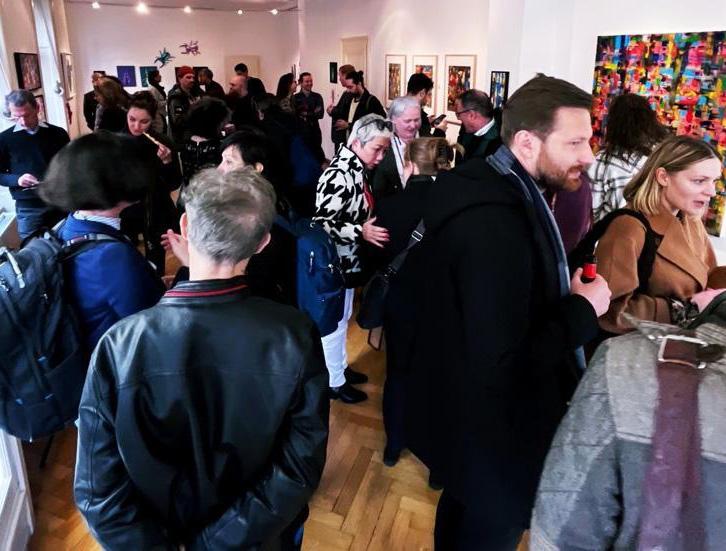

For me, it was a symbolism of an enlightened human being with different opinions, emotions and confessions. Balintatao is going the same direction but induced with the concept of judgment and idealism. There is a limitless possibility when one daydreams. It could be full of judgment, ideals, or terrible imaginations. And this is what I want to show in order to convince people that it’s normal to think or act however we wish, because at the end of the day, we only have ourselves to judge.”
Follow Arlo Jake Lagmay on IG: art.ist.arlo
www.artistarlo.com

The project “Silid-aralan sa Embahada” aims to connect students to their heritage and create a community among FilipinoSwedish families.Words by Maria Gutehall
Photos courtesy of the Philippine Embassy in Sweden
Afamous philosopher once said, “every new beginning comes from some other beginning’s end.” Things begin. Some things end. The end of one thing leads to the beginning of another. As humans, we need to keep our lives full and transfer that knowledge and wisdom to the next generation.
We need to leave some kind of legacy or footprint to remember. As we journey through life, we travel, we work in various foreign countries and then before we know it, we get used to the nomadic lifestyle. Some people migrate to other countries, meet their partner and have children. We tend to settle in another place away from home. The ordinary Filipino life may not be as interesting. We gain strength, courage and confidence from every experi-
ence. This makes us search for more, and we desire experiences more than our Filipino lifestyle could offer.
In Sweden, there are approximately 25,000 registered Filipinos in 2018. This represents the number of people who migrated to Sweden for work, marriage and education. A chunk of this population are Filipinos who have children with two cultural backgrounds, who may also have different sets of values, religion and languages.
For this reason, the Embassy of the Philippines in Sweden conducted classes on the Philippine language, history, geography, culture and traditions for children between the
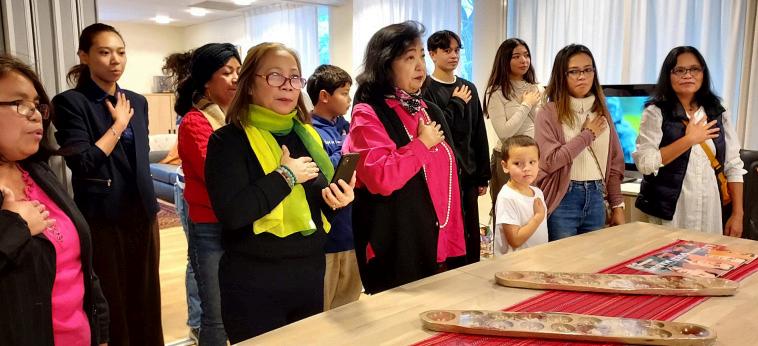
ages of 5 and 17 years of age in the first semester of 2023. The project, “Silid-aralan sa Embahada 2023,” ran from 11 March to 27 May 2023. This program aimed to equip students with the knowledge and training to be the next generation of leaders. With hope, this can help in infusing biracial Filipino-Swedish children with Filipino values.
It may be a challenging task for the Philippine Embassy to create this program. However, it succeeded in implementing the inaugural silid-aralan as it helped students connect with their heritage and create a community among Filipino-Swedish families. The Philippine Embassy plans to launch the second edition in the second quarter of 2024.
Aiming to promote Philippine heritage through books and publications, the Philippine Embassy, in partnership with the Philippine Education Society (PES), established a Fili-
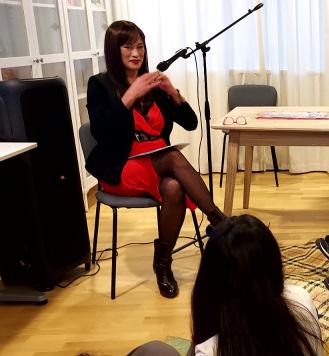
piniana library at its chancery.
By disseminating knowledge and information on Philippine culture, the Embassy promotes education, awareness, and understanding of the Philippines. The library specifically aims to create a deeper awareness and appreciation of the Philippine culture and heritage among the second and third generations of the Filipino community in Sweden. It will house a collection of books on Philippine history, arts and culture, literature, religion, economy, government and other subjects.
This project with PES may also include providing more literature and references about the Philippines in the collection of libraries in Stockholm
(and other parts of Sweden) through a donation process. The Embassy hopes that these books will ultimately cultivate a better understanding of Philippine history and heritage, as well as develop people-to-people ties with Swedish society. It also seeks to establish more meaningful friendships among Swedes and Filipinos.
The Philippine Embassy has limited collections of children’s books — books about children’s stories, folklore, myths and legends. The library has books about Filipino heroes and a 12part encyclopaedia of the arts of the Philippines. The library has paintings by Filipino artists and a small collection of Philippine games such as the icon-
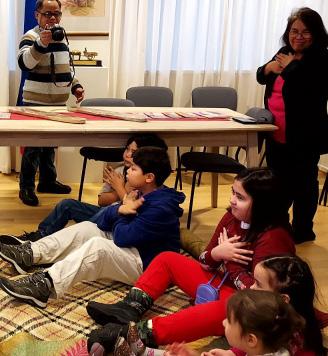
ic Filipino old-time favourite game “sungka.” The Philippine Embassy is looking for ways to expand further the collection with the help of PES and the Filipino community.
This project of the Philippine Embassy of Sweden is in partnership with the Philippine Education Society (PES), which is under the leadership of Mr. Noli Buhay. Ms. Saoy and Ms. Simpson are the officers of the PES. They have been very supportive together with other officers, Ms. Ditas Enstrom and Ms. Adel Buhay, in carrying out the plans and programs of the Philippine Embassy in the area of culture and in reaching out to and engaging with the Filipino community in Sweden.
Filipino parents raising a child with two cultures must instil pride in Philippine culture and talk positively about others, encouraging them to have multicultural experiences, through music, art and friendships. This is an opportunity for the children to integrate with children of other cultures, backgrounds and beliefs. Children who are introduced to diversity from an early age are more likely to grow up tolerant and respectful of other people.
However, culture also influences emotion in various ways. Culture constrains how emotions are felt and expressed in each cultural context. It shapes the ways people should feel in certain situations and the ways people should express their emotions.
For the Filipino community in Sweden and other countries in Europe who are raising their children in two cultures, how do you want your children to know and learn about our values as Filipinos?
Roots & Wings e-Publications have been making an impact on the Euro-Filipino community in the last dozen years by promoting Filipino culture, art, entrepreneurship, outstanding Filipinos in various fields, community events and providing current contacts to diplomatic missions within Europe. See list here.
Embassy information changes all the time. Help us update this directory by emailing rawmags.betsy@gmail.com.
Embassy of the Philippines, Vienna
H.E. Ambassador Evangelina Lourdes A. Bernas
20th and 21st Floor, ARES Tower
Donau-City-Strasse 11, A-1220
Vienna, Austria
Tel (+43-1) 533-2401
Emergency Tel (+43-6991) 232-2034
Email: vienna.pe@dfa.gov.ph vienna.pm@dfa.gov.ph WWW.VIENNAPE.DFA.GOV.PH
Embassy of the Philippines, Brussels
H.E. Ambassador Jaime Victor B. Leda
297 Avenue Moliere, Brussels, 1050 BELGIUM
Tel (+32-2) 34033-77 to 78
Emergency Tel (+32-4) 8860-9177
Email: brussels.pe@dfa.gov.ph; brusselspe@gmail.com
Facebook: @PHinBelgium
WWW.BRUSSELSPE.DFA.GOV.PH
Embassy of the Philippines, Prague
H.E. Ambassador Eduardo R. Meñez
Senovazne Namesti 8, Prague 1, 110 00 Czech Republic
Tel (+420) 224-216397 (+420) 224-216397 / 224-216385
Emergency Tel (+420) 607-850-764
Email: prague.pe@dfa.gov.ph; praguepe@gmail.com
Facebook: @PHinCzechRepublic WWW.PRAGUEPE.DFA.GOV.PH
Embassy of the Philippines, Copenhagen
H.E. Ambassador Leo M. Herrera-Lim
Arne Jacobsens Alle 13, 1st Floor, 2300
Copenhagen, Denmark
Tel (+45) 7141-5952
Emergency (+45) 2273-3933
Email: copenhagen.pe@dfa.gov.ph
Facebook: @PHinDenmark
WWW.COPENHAGENPE.DFA.GOV.PH
FINLAND
Hon. Consulate General in Helsinki
Ms. Maria Kauppinen
Honorary Consul
Ylisrinne 6A-T2, 02210 Espoo Finland
Tel (+358) 400 913 243
EMAIL: DCKAUPPINEN.M@GMAIL.COM
FRANCE
Embassy of the Philippines, Paris
H.E Ambassador Junever M. Mahilum-West
4 Hameau de Boulainvilliers
45 Rue du Ranelagh
75016 Paris, France
Tel (+331) 4414-5700
(+331) 4414-5700 4414-5701/2 (Consular)
Emergency (+336) 2059-2515 (+336) 2059-2515
Email: paris.pe@dfa.gov.ph parispe.dfa@gmail.com
Facebook: @PHinFrance
WWW.PARISPE.DFA.GOV.PH
GERMANY
Embassy of the Philippines, Berlin H.E. Ambassador Irene Susan B. Natividad Luisenstrasse 16, 10117 Berlin-Mitte Federal Republic of Germany
Tel +49 (0) 30 864 95 00
Emergency +49 (0) 173-521-5703
Email: info@philippine-embassy.de, consular@ philippine-embassy.de
Facebook: http://www.facebook.com/ PHinGermany
WWW.PHILIPPINE-EMBASSY.DE
Consulate General of the Philippines, Frankfurt Westend Carree
Grüneburgweg 16-18, 1st Floor
60322 Frankfurt Am Main
Federal Republic of Germany
Tel (+49) (0) 69 8700 66900
Hotline (+49) (0) 151 6248 7425
Assistance to Nationals (+49) (0) 151 5354 6841
Email: frankfurt.pcg@dfa.gov.ph
Facebook: https://www.facebook.com/ PHinFrankfurt/ WWW.FRANKFURTPCG.DE
WWW.FRANKFURTPCG.DFA.GOV.PH/
GREECE
Embassy of the Philippines, Athens
H.E. Ambassador Giovanni E. Palec
26 Antheon Street, Paleo Psychico 154-52
Athens, Greece
Tel (+30210) 672-1883
(+30210) 672-1883
672-1837
Emergency (+30-697) 968-2921, (+30-697) 968-2921
Email: athens.pe@dfa.gov.ph; ATHENSPE@OTENET.GR
HUNGARY
Embassy of the Philippines, Budapest
H.E. Ambassador Frank R. Cimafranca
1026 Budapest, Gabor Aron utca 58 Budapest, Hungary
Tel (+36-1) 391-4300
Email: budapest.pe@dfa.gov.ph / phbuda@philembassy.hu
Facebook: @PHLinHungary WWW.BUDAPESTPE.DFA.GOV.PH
ISRAEL
Embassy of the Philippines, Tel-Aviv
H.E. Ambassador Pedro Laylo Jr. No. 18 Bnei Dan Street, Tel-Aviv, 62260 Israel Tel (+9723) 601-0500 (+9723) 601-0500
Emergency (+972-54) 466-1188 (+972-54) 466-1188
Email: telaviv.pe@dfa.gov.ph; filembis@netvision.net.il WWW.PHILEMBTELAVIV.CO.IL
ITALY
Embassy of the Philippines, Rome
H.E. Ambassador Neal Imperial Viale delle Medaglie d’Oro 112-114 00136 Rome, Italy
Tel (+3906) 3974-6621 (+3906) 3974-6621
Emergency (+39) 328-690-7613 (+39) 328-690-7613
Email: rome.pe@dfa.gov.ph romepe2007@gmail.com WWW.PHILEMBASSY-ROME.NET
THE NETHERLANDS
EMBASSY OF THE REPUBLIC OF THE PHILIPPINES, THE HAGUE
H.E. Ambassador Jose Eduardo Malaya
Tel (+31) 70360-4820
Emergency (+31)(0) 65261-1079
Email: thehague.pe@dfa.gov.ph / thehague@ philembassy.nl
Facebook: @PHinTheNetherlands WWW.THEHAGUEPE.DFA.GOV.PH
NORWAY
Embassy of the Philippines, Oslo
H.E. Ambassador Enrico T. Fos
Nedre Vollgate 4, 0158 Oslo, Norway
P.O. Box 1758 VIKA N-0122 Oslo, Norway (+47) 224-00900 (+47) 224-00900
Emergency (+47) 902 41 171
Email: helpdesk@philembassy.no WWW.PHILEMBASSY.NO
ICELAND
Philippine Consulate, Reykjavik, Iceland
H.E. Consul Maria Priscilla Zanoria a.h
Skógarsel 39
109 Reykjavik, Iceland
Tel (+354) 897 5391
EMAIL: PHILCONSUL@SIMNET.IS
POLAND
Embassy of the Philippines, Warsaw
H.E. Ambassador Leah M. Basinang-Ruiz
Ul. Lentza 11, 02-956 Warsaw, Republic of Poland
Tel +48 22 490 2025 and +48 694 491 664
Emergency +48 604 357 396
Email: warsaw.pe@dfa.gov.ph
Facebook: @PHLinPoland WWW.WARSAWPE.DFA.GOV.PH
PORTUGAL
Embassy of the Philippines, Lisbon
H.E. Ambassador Paul Raymund P. Cortes
Rua Barata Salgueiro 30–3 andar
1250-044 Lisbon, Portugal
Tel (+351) 216-083-274; 216-083-276;
216-083-277
Emergency (+351) 925-410-257
E-mail: lisbon.pe@dfa.gov.ph lisbon.pe@gmail.com
WWW.LISBONPE.DFA.GOV.PH
Embassy of the Philippines, Moscow
H.E. Ambassador Igor G. Bailan
Pereulok 8 Building 1, 121099 Moscow, Russian Federation
Tel (+7-499) 241-0563; 241-0564; 241-0565)
Email: moscow.pe@dfa.gov.ph moscowpe@mailfrom.ru
Facebook: Philembassy Moscow WWW.MOSCOWPE.DFA.GOV.PH
Embassy of the Philippines, Madrid
H.E Ambassador Philippe J. Lhuillier
Calle Eresma 2, 28002 Madrid, Spain (Chancery)
Calle Guadalquivir 6, 28002 Madrid, Spain (Consular Section)
Tel (+34) 917-823-830 / 917-823-836; 917-451734 (Consular Section)
Emergency (+34) 616-491-861
Email: madrid.pe@dfa.gov.ph / madridpe@yahoo.com
Consular: info@philembassymadrid. com / consular@philembassymadrid.com
Facebook: @PHinSpain
www.philembassymadrid.com
WWW.MADRIPE.DFA.GOV.PH
Consulate General Barcelona
Consul General Maria Theresa S.M. Lazaro Rambla de Catalunya 33, Planta Principal 08007 Barcelona, Spain
+34 938 28 83 12
BARCELONAPCG.CONSULAR@DFA.GOV.PH
Embassy of the Philippines in Stockholm, Sweden Address Grenstigen 2A, 181 31 Lidingö, Sweden. H.E. Ambassador Maria Lumen B. Isleta
Tel + 46 70 8474780
Email phiinsweden@gmail.com
Mobile +46 702 735 407,
+63 9054039435 (Viber)
EMAIL: STOCKHOLM.PE@DFA.GOV.PH
SWITZERLAND
Embassy of the Philippines, Berne
H.E. Ambassador Bernard Faustino M. Dy Kirchenfeldstrasse 73-75
3005 Berne, Switzerland
Tel (+41-31) 350-1700
Emergency (+41-79) 542-1992
Email: berne.pe@dfa.gov.ph / info@philembassyberne.ch
Facebook: @PHinSwitzerland
WWW.BERNEPE.DFA.GOV.PH
Permanent Representative to United Nations Office at Geneva
H.E. Ambassador Evan P. Garcia
47 Avenue Blac, 1202 Geneva Switzerland
Tel (+41-22) 716-1930
Emergency (+41-79) 1369-114
Email: geneva.pm@dfa.gov.ph / genevapm49@ gmail.com
genevapm.dfa.gov.ph
WWW.FACEBOOK.COM/GENEVAPCG
UNITED KINGDOM
Embassy of the Philippines, London H.E. Ambassador Teodoro L. Locsin Jr.
6-8 Suffolk Street, London SW1Y 4HG United Kingdom of Great Britain
Tel (+44) 20-7451-1780
Emergency (+44) 78-0279-0695
Email: london.pe@dfa.gov.ph / embassy@philemb.co.uk
Facebook: @PHLinUK
WWW.LONDONPE.DFA.GOV.PH
VATICAN, ITALY
Embassy of the Philippines, Vatican
H.E. Ambassador Myla Grace Regina Macahilig
Charge d’ Affaires
Via Paolo VI, 29, 00193 Rome, Italy
Tel (+39-06) 6830-8020
Email: vatican.pe@dfa.gov.ph / vaticanpe2@gmail.com
https://dfa.gov.ph/about/dfa-directory/ourforeign-service-posts-dfa
WWW.VATICANPE.DFA.GOV.PH
 Interview by Ralph Chan
Interview by Ralph Chan
It was named ”Totoy” because my parents have been asking me since I was a child in Filipino, ”Totoy, ano ba ’yan?” which means ”Little boy, what does that mean?”
Official documents such as doctors’ letters or letters from authorities are notoriously difficult to read. Even people whose native language the document is written in find it difficult. The problem is even bigger for people with a migration background who may not speak the language or do not understand the documents due to other handicaps. Roots & Wings had the privilege to talk with Francis Rafal, the CEO and co-founder of Totoy, who developed an app to provide a remedy to this situation.
Who is Francis Rafal?
I’ve always been interested in computers. As a child, I programmed my first websites and tried to learn HTML and C. During my community service, after graduating from high school, I ran a computer course and taught seniors how to use computers. At the same time, I started producing and editing videos as a hobby and uploaded my first videos to YouTube.
At some point, my first customer came to me and asked if I could make a video for him too. I actually founded my first company out of necessity, be-
cause I was looking for a legal way to produce videos in order and earn money from them. My hobby turned into a career.
After two years, my film production company Rafal Studios was actually doing so well. We produced commercials and short films. Unfortunately, however, this film production failed because I didn’t really have the skills in liquidity planning at the time, and I realized too late that it was no longer suitable in terms of liquidity. Furthermore, we also had three payment defaults, because customers didn’t pay for finished videos. I had to lay off all employees and was €100,000 in debt.
Over five and a half years I paid off this debt privately by co-founding other companies, including Content Creation


School and Ninjawerk. Content Creation School was a training company through which we taught companies how to produce video content themselves, including using their mobile phones. Ninjawerk is a hardware startup for film accessories with which we developed a gimbal, a stabilization system for cameras.
The Content Creation School no longer exists because after I paid off the debt, I realized that I wanted to go somewhere else with my business, so I liquidated both the Content Creation School and Rafal Studios. After Content Creation School, I wanted to focus more on my interest in software and really learn to program. And that’s how I came across the new programming school in Vienna, 42 Vienna, where I’ve been learning programming
since 2022. This is also where the idea for our app, Totoy, came from, and where I met my Totoy co-founders.
How did you become interested in entrepreneurship?
For me, entrepreneurship basically consists of two tasks: do good and talk about it. By “do good” I mean create a good product or service that solves a problem. By “talking about it” I mean bringing this product or service to customers. What’s special about Totoy is that it’s the first time I’ve co-founded a social business.
Basically, there are three types of organizations. Profit-first organizations, which are organizations that are purely about profit, i.e. companies. There are impact-first organizations, i.e. organizations that want to bring about a specific social or ecological change; these are NGOs. And social businesses are hybrid organizations. A social business wants to bring about social or ecological change, but at the same time be economically sustainable. And that’s what we want to do with Totoy: We want to solve the problems of
functional illiteracy and invisible language work with an economically and technically scalable app.
Can you talk more about the development of Totoy App?
The idea for an app that explains letters from authorities using artificial intelligence came about by chance in 2022. Over dinner, a colleague and I talked about our experiences of having to translate and explain letters from the authorities and complicated documents for our parents since we were kids. Our parents can read and write German but have problems with complicated legal terms. The idea initially disappeared, but as I was studying software engineering at the programming school 42 Vienna, I had gathered enough skills to build a first prototype of the app in March 2023, using only the Apple Shortcuts app.
This is an app on the mobile phone that you can use to program using drag-and-drop. I showed this prototype to my parents, who were really excited about it, and then I showed the app to my fellow students Simon Hoffmann, Marcel

Learn more about the TotoyApp here:
https://www. youtube.com/@ TotoyApp
https://www.instagram.com/TotoyApp
https://www.linkedin.com/company/ totoyapp
https://www.facebook.com/TotoyApp
https://www.tiktok. com/@TotoyApp
https://twitter.com/ TotoyApp
https://www. threads.net/@ totoyapp

Koller, Benedikt Hielscher and Michael Perger. After the first demo, the five of us decided to work on the app full-time alongside our studies. In September 2023, we released the app for iPhone and Android. It was named ”Totoy” because my parents have been asking me since I was a child in Filipino, ”Totoy, ano ba ’yan?” which means ”Little boy, what does that mean?”
What is the app actually about?
Totoy is basically the answer to a problem that has been close to our heart for a long time. As a child of Filipino immigrants, I was often the bridge between complex letters to the authorities and my parents, who knew German but struggled with the legal details. This experience led me and my team to develop Totoy — an app that not only translates but also explains things in simple language. In contrast to conventional translation apps, Totoy goes one step further: With Totoy on their mobile phone, users can scan documents in 95 languages and the app explains them in 18 simple languages.
Marcel Koller Co-Founder and Backend Developer
We are trying to solve two problems with the app: functional illiteracy and invisible language work. A person affected by functional illiteracy has difficulty understanding complex texts such as contracts or a medical information sheet. With Totoy we want to help these people become more independent. Furthermore, many migrants are socalled functionally illiterate in their second language. This means that they have a high level of language competence in their native language and understand complicated texts but have problems with letters from authorities or doctors’ letters in the local language.
The children of those affected are often used as translators, but they also fulfill the function of family lawyer or family tax advisor. With Totoy, we want to relieve migrant children of the invisible language work and enable them to have a childhood without adult responsibilities. Over the course of the year, we will have 50 languages and gradually develop Totoy into an AI assistant for all things official. A grant from the Vienna Business Agen-

cy, which we have received, is helping us to achieve our goals.
Do you have any advice for new Filipino entrepreneurs of your generation? Are there any mistakes to avoid or things you can advise them to do?
Entrepreneurs have one main task: make sure that the company doesn’t die because it runs out of money. And the most important tool for this is liquidity planning. I wish I had known that before I started my first company. And accounting is not the same as liquidity planning. Accounting always deals with the past. Liquidity planning for the future. Accounting can be delegated to a tax advisor. Nobody can do liquidity planning for you, which is why you should definitely learn this skill. And all I can say is: Building and running a company is not easy. Every day you have to fight with new stumbling blocks. You need resilience and you have to build it up, even with external help such as a psychotherapist or coach. But if what is said about Filipinos is true, that they are particularly resilient, then they are actually the ideal founders.

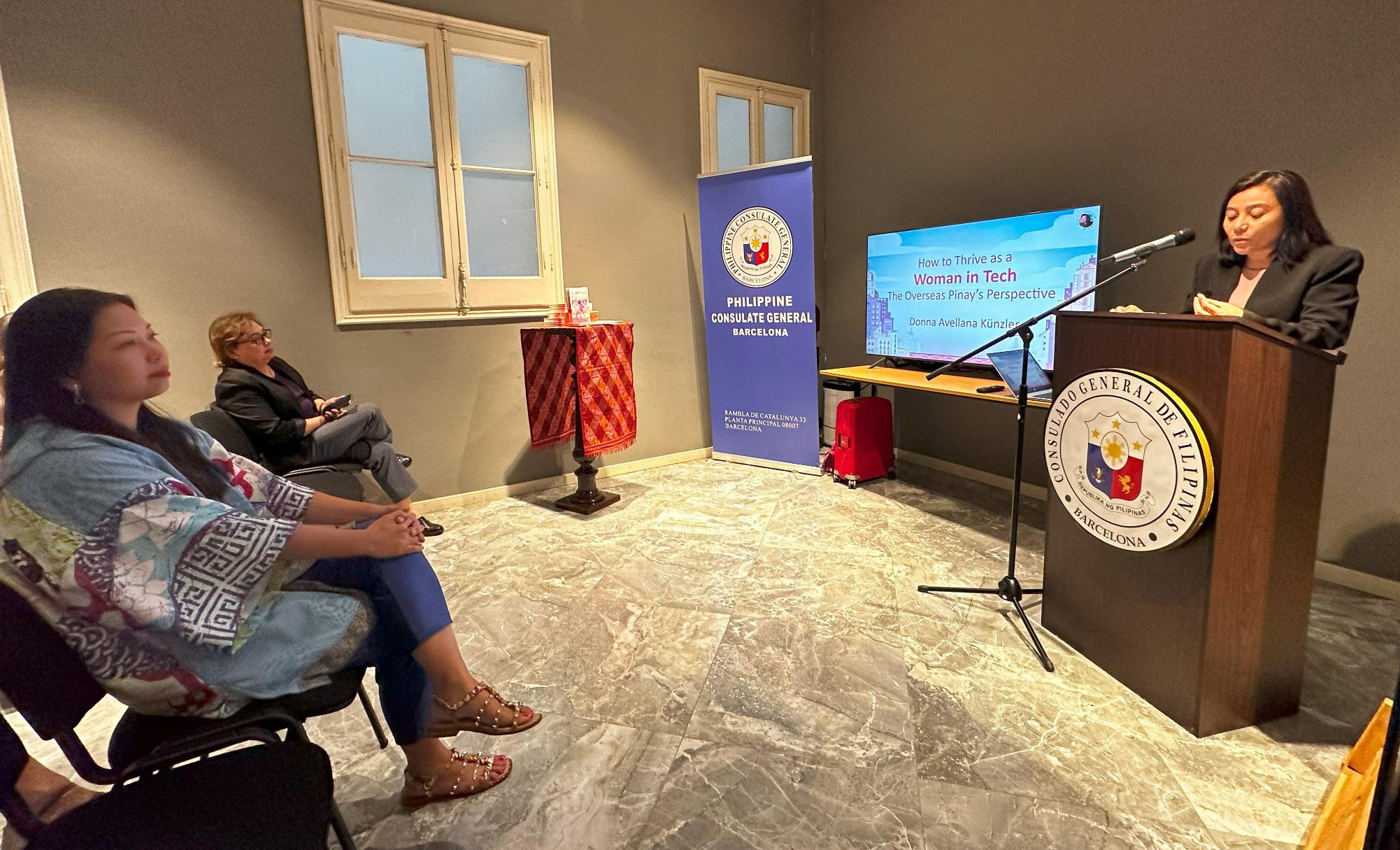
BARCELONA, September 27, 2023 — The Philippine Consulate General in Barcelona proudly hosted an empowering evening with Donna Kunzler, author of The Overseas Fabulous Pinay on 27 September 2023 at the Consulate General’s premises.
Organized as a Gender and Development (GAD) activity, in accordance with the GAD policies and objectives of the Department of Foreign Affairs (DFA), the event highlighted the Consulate General’s commitment to empowering women in the diaspora and encouraging them to upskill and venture beyond their comfort zones. Donna Kunzler–who has worked for E&Y and Sin-
gapore Airlines in Singapore, and PwC in the Philippines, US, UK and Switzerland as an information technology auditor and consultant for most of her career–shared invaluable insights on thriving as a woman in the tech and corporate world. She offered practical tips for overcoming common challenges and engaged with a vibrant audience of young Filipinos working in the tech sector in Barcelona. Attendees had the unique opportunity to seek her advice and gain inspiration from her journey.
Consul General Maria Theresa S.M. Lazaro expressed her enthusiasm for the event, saying, ”The Consulate General is dedicated to the upskilling
and empowerment of Filipino migrant workers in our jurisdiction. Donna Kunzler’s experience is relevant to Filipinos who are finding their way in these industries, and we are committed to providing opportunities for our community to thrive in various fields, including tech and corporate sectors.”
The event was a testament to the Consulate General’s commitment to empowering the Filipino diaspora, especially the burgeoning community of tech professionals in Barcelona. The Consulate aims for the activity to be the beginning of a platform for knowledge-sharing and fostering a supportive network among Filipinos working in the dynamic tech landscape of Catalonia.
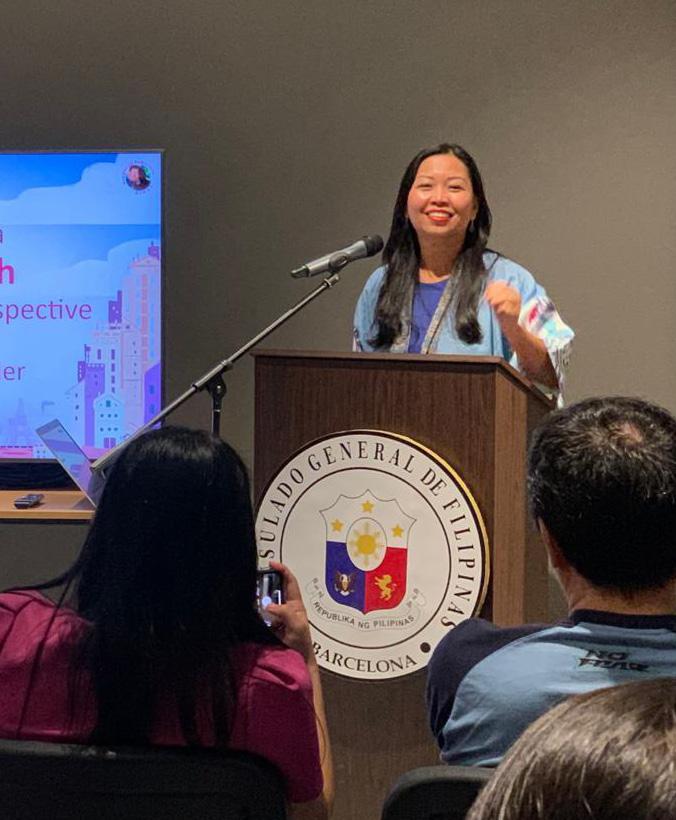


For more information or inquiries, please contact: The Philippine Consulate General in Barcelona barcelona.pcg @dfa.gov.ph

I loved my life in London, but my other home, the Philippines, was calling. There was just something that was missing in my life.
 Words by Stella Aquino
Words by Stella Aquino
After spending 11 years in London, I made the bold decision to resign from my stable job and relocate to the Philippines, a move I had long desired. The timing had always been uncertain, but familial circumstances finally prompted me to take the leap. My partner and I gradually emptied our London apart-
ment, parting with possessions through sales and donations.
Half French, half Filipina, I grew up in Luxembourg and studied in France and Germany. Upon graduating, I had to do an internship to validate my master’s degree in finance. My initial choice was Singapore at that time, but unfortunately, a visa was very difficult to acquire for a French citizen. With limited time, I accepted

an internship in London. After just three months, I was offered a permanent job that I couldn’t refuse. I thought I would eventually move to Asia but ended up staying 11 years. Meeting my significant other likely influenced my decision, as did my advancement in the financial sector. London is undeniably the place to be for a finance career. I loved my life in London, but my other home,
the Philippines, was calling. There was just something that was missing in my life.
As we prepared for the move, we arranged for the shipment of our belongings via balikbayan boxes and booked our one-way flight to Cebu, via Dubai. LT Express delivered and picked up the boxes. There was no way of tracking them, but they would give us updates as to where they were and when they would be delivered. I gave a family member’s address in Cebu, where we were initially moving. After three months, they arrived!
The day arrived and we boarded the plane. It was finally happening. Landing in Cebu was really smooth. I have to say the Mactan International Airport is way better than the Manila airport. It is newly built, with bamboo material, I never experienced queueing and the taxis are easier to get. Our Cebu life finally started!
So how has life in Cebu been? So far, everything has been great. Cebu is more relaxed than Manila. Everything is close by and convenient. Of course, there is traffic, but if you understand the busy times and travel accordingly, you will never be in a car for more than 30 minutes. Admittedly, in the beginning I experienced reverse culture shock. You just have to be armed with patience. Understand that yes means no, that there is “no stock, ma’am,” or that they know but don’t. Once you embrace the changes, you can finally enjoy it.
The weather plays a big part. It is always hot and sunny, and recently not humid and always a little windy. I wouldn't trade anything for London weather. Daily life is also easier, as


we had moved to IT Park. The mall is right next door and has everything you need. For food, Metro supermarket doesn’t have everything, so occasionally we go to The Marketplace which has more international selection and a more appealing
meat and fish section. There is also Landers, S&R and some specialized shops. One in particular is The Italian Food Specialists, which my Italian partner discovered. You can find all the Italian cheeses, hams and more.
Visiting Cebu has been fun, and I began recording my excursions and condominium tours on my Youtube channel, @Stella_aquino. Real estate being my passion, and having invested in a few condominiums, I wanted to explore and see more. I went to see several developers and visited their showrooms and also actual units. I began having more viewers and people asking me privately for condominium prices.
We tried a few restaurants and rooftop bars in Cebu and enjoyed the slower paced life, especially after having lived the crazy and manic London life. I guess it was time to slow down while also looking at all the business opportunities. I started to go to the French expats meetings and realized that the French community is very small, but very helpful. I met a contact who was an attaché to the French Embassy and kept in touch. He gave me some very good contacts which will benefit my (our) future business endeavors.
As I wanted to be able to work freely in the Philippines, I started the process of acquiring a Quota Immigrant Visa. I knew there were a lot of requirements and had actually asked the agency I currently use last year. I still have the hope to become truly Filipino one day (my mother was French at the time of my birth and reacquired her citizenship
Rebecca and I catching up at The Reef Island Resort Mactan, Cebu Cebu City view
when I was already over 18). Dealing with the administration was another interesting experience.
All the efforts paid off and recently, I received approval for my Quota Visa and was overjoyed. I also seized an unexpected opportunity in Manila, necessitating a trip for biometrics while I was in Siargao. Despite the logistical challenges, I conducted interviews over Zoom and met with the team in Manila after fulfilling the Bureau of Immigration requirements.

use, investment, or passive income. With firsthand experience in acquiring properties in Manila and Cebu, I’m eager to assist fellow kababayans in navigating the market.
I am excited to share that I
will be joining Federal Land as a Senior Regional Sales Manager within the International Sales Group. Federal Land has properties in both Cebu and Greater Manila. It’s an opportune time to invest in Philippine real estate for personal
Having finally settled in Manila, our Philippine adventure is just beginning. We are excited for what is still to come, forging connections with fellow expats and investors, as well as reuniting with beloved family and friends. The future is exciting. Mahal ko ang Pilipinas!
Keep up with me here: contact@stellaaquino.com
www.youtube.com/@stella_aquino/videos
and images
by Gloria Hernandez GrejaldeTravel back in time as you walk through the aisles and the courtyards of century old churches.
Dig into Manila’s rich historical past. Travel back in time as you walk through the aisles and the courtyards of century old churches. These were vestiges of over 300 years of Spanish colonization that turned the Philippines into the lone Catholic nation in Asia.
The country’s uniqueness from other Asian countries that are either Buddhist or Muslim makes it an ideal pilgrimage place among Christ believers and an alternative destination to European cities where amazing ancient churches draw many tourists.
Malate Church
A church highlighting a fusion of Moorish and Mexican Baroque design in its facade, Malate Church, also known as the Our Lady of Remedios Parish, was founded in 1588. The Augustinians missionaries brought the image of its patron, Our Lady of Remedios from Spain in 1624.

Located along Roxas Boulevard, overlooking Manila Bay, the church was used as headquarters by the British colonizers in 1762. A strong typhoon destroyed the church
in 1868, and it was restored between 1894 and 1898. During the Japanese occupation, fire damaged the church. Colombian priests rebuilt it in the 1950s.

The Minor Basilica has undergone several renovations since it was built in 1571 — after it was ravaged by fire, destroyed by earthquakes and damaged by war. It was rebuilt in 1958 adopting a Neo-Romanesque architecture. The church aisle was designed as a Latin cross, wherein you can admire the artistic stained-glass windows designed and created by Filipino artist Galo Ocampo.
Italian artists sculpted the religious images in the cathedral. Its patron image of the Blessed Virgin Mary, the Immaculate Conception was by Vicenzo Assenza, Italy’s national sculptor. Publio Morbiducci, a famous artist during the reign of Mussolini, was

responsible for the baptismal font and the angel-shaped holy water fonts, while the mosaic of Our Lady of Sorrows that adorns the wall in the crypt was by artist Marcello Mazzoli.
There is also the statue of Saint Rose of Lima sculpted by Angelo Fattinanzi. The images of Saints Jacob, Andrew, and Anthony the Abbot were by Livia Papini while those of Francis Xavier and Polycarp were by Alcide Tico.
The Latin inscription in one of the arches in the entrance that reads Tibi cordi tuo immaculato concredimus nos ac consecramus (To thy Immaculate Heart, entrust us and concentrate us) greets the churchgoers.


The 14th century San Agustin Church is the oldest stone church in the Philippines. It was established in 1571. Construction of its stone structure began in 1586 and was completed in 1607. The design was patterned from some of the magnificent temples in Mexico. Listed as a UNESCO world heritage site, the church is also a national historical landmark. It is also known as the Archdiocesan Shrine of Our Lady of Consolation and Cincture.
Stepping inside, the church will take you to medieval time with its Baroque design — the fully carved choir seats with ivory inlays, the elegant antique chandeliers from France, the trompe-l’oeil murals painted on the ceilings and walls by Italian artists Giovanni Dibella and Cesare Alberoni. Tombs of Spanish conquistador Miguel Lopez de Legaspi, famous painter Juan Luna, Jose Rizal’s friend Trinidad Pardo de Tavera are among the famous and influential names that can be found in the church.
It was also a silent witness to the conclusion of the Spanish-American War in 1891. Spanish governor-general Fermin Jaudenes drafted the terms for the surrender of Manila to the United States of America inside the church.
During the Japanese occupation of World War II, it was used as a concentration camp.
Outside the Spanish enclave across the Pasig River was the area dominated by the Chinese. The oldest Chinatown in the world, you will find the 16th-century Baroque Binondo Church known as the Minor Basilica and National Shrine of Saint Lorenzo Ruiz. Also called the Our Lady of the Most Holy Rosary Parish, it was founded in 1596 by the Dominican priests.
The bell tower is an octagonal pagoda to indicate the presence of the Chinese parishioners. The main altar is a miniature of the facade of the St. Peter’s Basilica in Rome.
National hero Andres Bonifacio and his wife Gregoria de Jesus were married in this church.




The Parish of Santa Cruz, also called the Our Lady of the Pillar Parish, was the first Catholic church built by the Jesuits in 1619. They brought the statue of Our Lady of the Pillar in 1643. The church is also known as the Archdiocesan Shrine of the Blessed Sacrament.
Earthquakes and war ravaged the original church; it was rebuilt in 1957. Art Deco and Romanesque architecture dominate the interior, while its facade reflects the Spanish Baroque style.



Franciscan friars established Quiapo Church in 1588. Now popularly known as the Minor Basilica and National Shrine of Jesus Nazareno (the Black Nazarene), the church was initially dedicated to Saint John the Baptist.
Augustinian missionaries brought the statue of Black Nazarene from Mexico on May 31, 1606. Many believe that the statue is miraculous. January 9 is the Feast of the Black Nazarene; it is a big yearly celebration.
Full construction of the
church started in 1686. It was renovated in 1933, following the design drawn by architect Juan Nakpil, the country’s National Artist. To date, only its facade, the dome, the transept and the apse retained its classic Mexican Baroque design.
Visible from a distance because of its towering twin spires, the 19th-century San Sebastian Church stands proudly from its location in Quiapo. Declared a national historical landmark, the church construction started in 1888 and completed in 1891. It was built in steel to make it fire and earthquake resistant. Prefabricated steels were from Belgium and Belgian engineers supervised its construction. Its design is a fusion of Baroque and Neo-Gothic architecture.
The church continues to have its original interiors showing Neo-Gothic lines with its metal doors, walls, ceilings and glass windows. The stained-glass windows were from Germany. On its main altar is the image of Our Lady of Mount Carmel, a gift from the Carmelite Sisters of Mexico City given in 1617.

